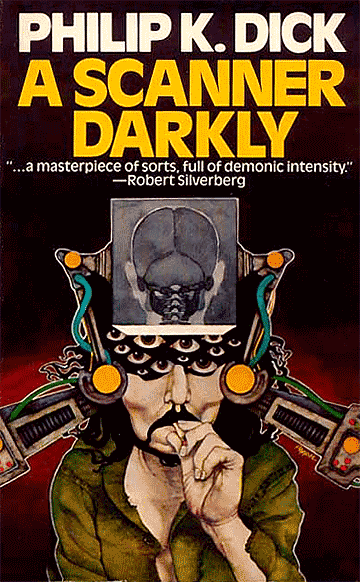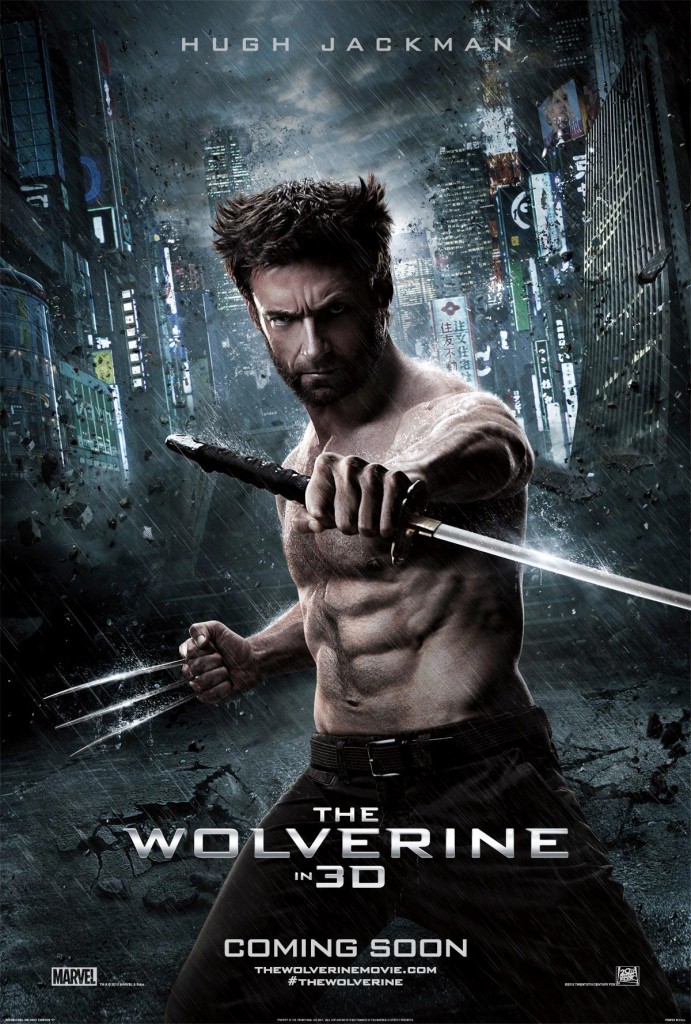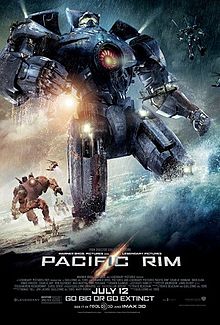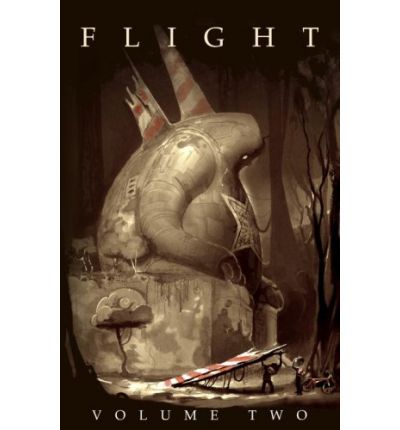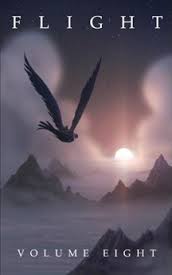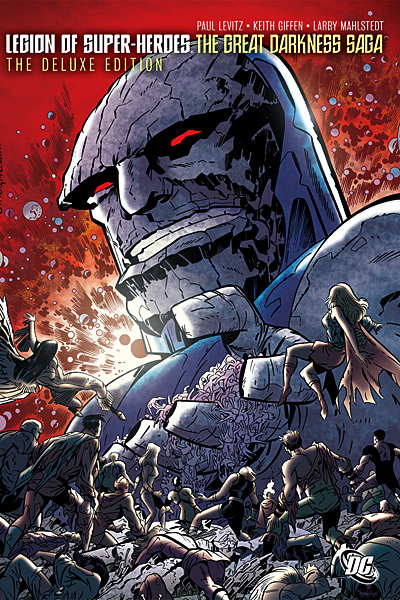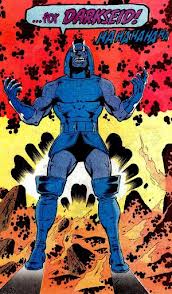My son Zen told me one day that he wants to see more Charlie Chaplin movies. Wow – what brought that up? Seems he had been reading about Chaplin in a book of biographies of famous people, and he wanted to see what Chaplin had to offer. Wow, you don’t have to ask me twice! We started off with Modern Times and watched it on a Friday night, laughing our asses off. What a great film! And then we saw another one… and another one… and another one. They’re all good.
If you want to see the films yourself, go here.
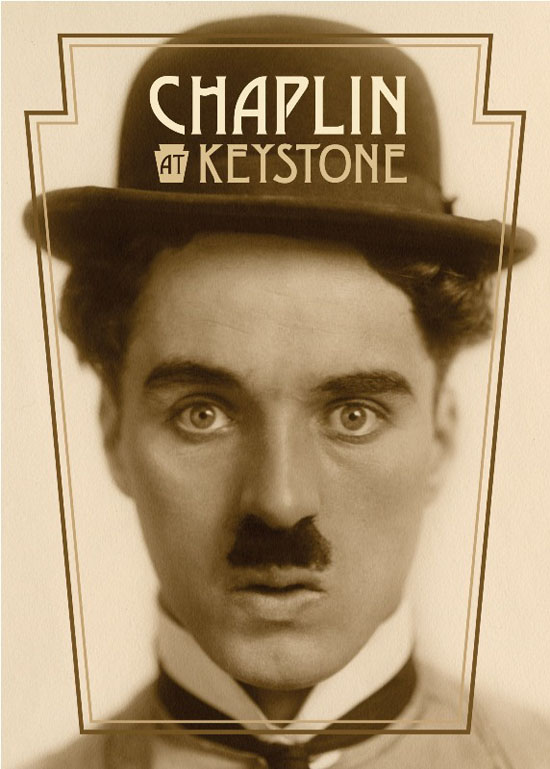
CAK
Chaplin At Keystone, collecting his 36 films from the Keystone, all done in 1914. The result of a massive restoration project, this set was released in 2010 and came with a nice booklet – Wow, a treasure trove!!
Making a Living (1914) – Chaplin’s first film, and he’s not yet in his famous Tramp outfit (that would come in his second film, and most of the subsequent ones as well). This time he’s some sort of ruthless, aggressive and out-of-work dandy journalist who’s trying to get married. Lots of hammy acting, and Chaplin steals the work of a romantic rival and gets in lots of chases and fights. Love how he jumps right onto someone in a fight. Dressed as a dandy, Chaplin’s head really looks extra-large, and here he seems more like the Mad Hatter than the Tramp. Real zaniness!
Kid Auto Races At Venice – A hysterical show featuring Chaplin mugging for a sports camera that’s trying to catch some sort of soap box racers rally or something. He often gets kicked and yanked and thrown around. It’s irritating, but also terribly funny; the concept recurs in later films, such as Mabel’s Day Out.
Mabel’s Strange Predicament – Charlie’s a smokin’ drunk in a hotel lobby, where he has plenty of opportunities to get clumsy and annoy people, falling all over himself, grabbing a dog’s tail, and all sorts of nonsense. He’s also a bit of a lech, making a grab for Mabel when she’s accidentally locked out of her hotel room; this, of course, results in a cat fight. Chaplin’s actually not in many of the scenes, Mabel has a few, as do the elderly couple, and Mabel’s beau. Chaplin istossed around like a rag doll – musta hurt! Amazing harridan beating up her husband she think has been cheating with Mabel, ha ha ha…
A Thief Catcher – This film has been lost! But it has been recovered again – see the extras section.
Between Showers – A lunatic thief steals an umbrella (why an umbrella) from a cop, and hilarity ensues when Chaplin and the thief try to help a very large lady cross the street. They fight with each other, then she comes in and beats them up! Nearly non-stop action here.
A Film Johnny – The Tramp wanders onto a film set and proves himself totally useless, there’s a goofy scene where he rolls his eyes and crosses them and makes goofy faces. He gets hold of a prop gun and starts blasting it off all over the place, even using it to light a cigarette! He also gets beaten up by a girl again!
This film has a scene where a film board appears with swastikas drawn on it. Huh? What could that have possibly meant to people living in 1914? Weird!!

A Film Johnny scene

A Film Johnny scene close-up

A Film Johnny scene – the Chapin undead!
Tango Tangles – Here he plays a lush that looks a bit like his Tramp (no mustache, though), who tries to pick up the hat check girl in a dance hall, but the band leader (played by the brilliant Ford Sterling) claims her for himself, as does the clarinetist (played by the massive Roscoe “Fatty” Arbuckle). Wow! Sterling is a nutcase, he over-acts impressively. Arbuckle is massive, and at one point he picks up a guy and throws him up in the air and over his shoulder. There’s lots of hilarious brawling here, and we see the surprisingly acrobatic Arbuckle go flying more than once. Here he was in top form! At one point Sterling gives Chaplin a big, long man kiss. Chaplin seems to be very good at playing drunks, he is well known for doing so in masterpieces such as “The Idle Rich” and “Limelight”. Nice!
His Favorite Pastime – Charlie is a bar patron who gets into hijinks and fights everybody, even the swinging door. He follows a pretty girl home and gets in a fight with her husband. There’s a white actor in blackface, probably one of the only times in a Keystone film (according to the notes in the booklet – I only recall one more that had such).
Cruel, Cruel Love – Charlie the dandy quarrels with his lover, then swallows what he believes to be poison (it is only water – see a similar scene in Monsieur Verdoux). Lots of fighting in this one, as well as a cool devil dream sequence, crazy mugging, and kung fu battle!
The Star Boarder – boarder Charlie gets more attention from his landlady than her husband and son get, he drinks their booze – drunk again, this is the third movie in a row! Compromising photos are revealed, chaos insures.
Mabel At The Wheel – Chaplin’s first two-reeler contains a lot of action, and has Charlie as a villain, with a strange two-pronged beard! Charlie with a very cool bike, Mabel gets dumped in a puddle, he becomes demented when Mabel goes off with another guy and he causes trouble with her boyfriend’s hot rod; when he can’t be found, she pilots it, to great success (see – Charlie also invented Women’s Liberation, it seems). Lots of nutty fighting, explosions, and race cars. It’s a White Zombie album! This one was directed by Mabel Normand herself, and it was not a happy experience for Chaplin, but it led to him getting the promise to be allowed to direct his normal films.
Twenty Minutes Of Love – The Tramp interferes with several kissing couples, groping each other exaggeratedly, and there’s the theft of a watch and a back and forth with the thief stealing from the thief that we later see in The Circus.
Caught In A Cabaret – Charlie the bumpy waiter, takes his dachshund for a walk, meets a rich lady (always girl hunting, that Charlie is), introduces himself as “Barond Doobugle, Prime Minister of Greenland”! And it all ends up with a brawl and gunshots. Yeeee-ha!
Interesting how there’s a Chinese temple in the neighborhood, outside the door of the pub. Terrible camera work, though!
Caught In The Rain – A lech, as always, in the park flirting with married women, funny sitting-on-flower gag. Move to the hotel, funny stairs scenes. Drunk, smoking, crazy undressing scene, where we get to see some details on the strange clothes that they wore in 1914 (fake collars, fake cuffs, a chest board…). Wow!! Nutty hotel comedy! While Chaplin had directed a few films by now, this was the first from his own scenario (and it plagiarized a few earlier pieces, including the park scenes, the drunkard bits, and the hotel disturbances seen already in earlier Keystone flicks.
A Busy Day – A very short film, this one is outstanding because it shows Charlie in drag, as a scrappy woman taking on all the guys, and even going onto the race track to recreate the concept of Kid Auto Races At Venice.
The Fatal Mallet – Another park film with nutty romantic rivalry, between Charlie and another fellow with an equally small hat and small jacket. Everyone ends up in the pool. Nice. Some incredible brick hitting and throwing!!
The Knockout – A longer piece, that features other actors until the final 30 minutes, when Charlie Chaplin (the director) enters as the referee of a fight that is about to occur. He, and the opponents, get throughly battered, and the film ends.
The film is significant, not because of Chaplin (who barely does anything interesting in his 10 minutes, other than get battered), but because of how it develops multiple characters, and a fairly complex story line; we also see several familiar actors that we know and love to supplant Chaplin, not to mention a bit of scandal with the young lady dressing up as a man (androgyny!!!) in order to see the fight.
Here we see Fatty Arbuckle again, for the first time since several films, alongside the beauty from the last film. We get a guy with an eye patch, some Keystone Cops, lots of brick tossing, as Fatty Arbuckle changes his clothes he asks the camera to scoot away (a bit of meta-filmmaking there), and the he comes out in ridiculous togs, including a sash!! The girl dresses up androgynously, prances like a man. The one guy has an excellent long mustache. The crowd is going nuts. The fight progresses as you’d expect, but then Fatty gets a hold on some sidearms and gunplay ensues, fights spreading across the whole neighborhood and its rooftops. The Keystone Cops come in – wow! Music includes lots of horns.
Mabel’s Busy Day – Not a fantastic film, Chaplin and Normand spend the day at the tracks getting into various scams and disagreements, eventually also taking part in some kung fu battles and such. There are also plenty of Keystone Cops around.
Mabel’s Married Life – Park flirt, some misunderstandings, and Chaplin drunk and has a fight with a boxing dummy. While the couple seems to be penniless, they do live in a very nice apartment.
Laughing Gas – The Tramp is still his sloppy old self as he antagonizes staff and patients alike in Dr Pain’s dentistry and initiates a brawl, also going so far as to beat up a comatose patient! Dr Pain!!!
The Property Man – Charlie the stage porter, pours beer down his pants, then beats and kicks the old man assistant very badly. Accidentally becomes part of the act, the audience loves him (shades of The Circus), and we get to see the nutty reaction of the people in the audience, including one guy with a very spooky face I call “white eyes” (he probably had deep blue eyes that showed up white in black and white footage). The backstage brawl with the water hose spills out into the audience, and everyone gets soaked, even the guy who slept through everything. Abrupt cut at the end, the way all of the Keystone films get cut.
The Face on the Bar Room Floor – A somewhat bizarre and serious drunken tale, Chaplin is a drunk who ells the sad tale of how he was an artist who fell in love with a woman, but lost her to one of his subjects; sexy shots of women smoking as they pose for the artist’s paintings. The drunken artist draws a portrait of his faithless lover on the barroom floor… but it’s chicken scratch, he’s too drunk. A strange piece, and one of only three Chaplin films to employ flashback (the others are Shoulder Arms, and the masterpiece Limelight.
Recreation – A fragment of only six minutes that is difficult to understand, the best print is highly deteriorated and very blurry and blotchy.
The Masquerader – One of the more remarkable Chaplin films from his first year of filmmaking, this shows Chaplin playing himself, dressed in his street attire, going into the studio dressing room to get made up as the Tramp, this time goofing off with Fatty Arbuckle and trying to steal his beer. Later he gets in a scene, flirts with some girls, gets fired, then comes back dressed as a woman to exact his revenge – he gets cast as a leading lady, then reveals himself and starts a brawl. Great!
His New Profession – a totally nutso entry, Chaplin is babysitting a gouty uncle, whom he neglects and leaves alone on a wharf as he goes drinking. Lots of savagery here too as Chaplin steals from a “cripple” who’s begging at the wharf. Quite funny, actually.
The Rounders – The only real team-up of Chaplin and Fatty Arbuckle (who otherwise appears in cameo roles), the two are rich drunks who escape from their shrewish wives (after plundering their purses) to go drinking together, but really they just cause trouble. Great tuxedo swaying and cute dance steps. The final scene in Echo Park (where so many Keystone Chaplin films ended up) where the duo end up as they try to escape their wives, shows our fellows falling asleep in a sinking boat. Suuuuure… why not?
Speaking of which, Arbuckle made a great comment about Chaplin and the times:
I have always regretted not having been his partner in a longer film than these one-reelers we made so rapidly. He is a complete comic genius, undoubtedly the only one of our time and he will be the only one who will be still talked about a century from now.”
Turns out Arbuckle was right, although it’s also true that he is still talked about somewhat, having been implicated in a brutal murder (he was acquired, and Chaplin defended him vigorously in his autobiography).
The New Janitor – Nice little crime drama as Charlie starts a new job as the worst janitor in LA; he prevents a murder and a robbery, but is nearly implicated in the crime. In the end he gets the girl – a rare case among Chaplin films. Funny scene of Chaplin pointing the gun between his legs at his adversary.
Those Love Pangs – Chaplin and Mr Walrus (Chester Conklin) chase any skirt they come across, and eventually meet two hookers, although their beaux battle them anyway. The film ends in a movie theatre where people watch films from folding chairs. A lot of nutty action in this one, including a scene of Chaplin using his bamboo cane as a toothpick (!!!).
Dough and Dynamite – a continuous brawl that literally includes dynamite as well. Chaplin is working in a restaurant where he fights with everyone – the washers, the waitresses, the clients, and the bakers. Hard to see how this restaurant can even produce food, ha ha… The original bakers had quit and tried to bomb the place in revenge by putting a piece of dynamite into a loaf of bread. Chaplin chucks it into the oven, and it soon enough ignites. The final scene shows Chaplin’s face coming up through the dough he’s been covered in. Apparently this was one of the most profitable, popular and famous film comedies of its era.
Gentlemen Of Nerve – More shenanigans at the race course, this time Charlie fights over a girl, fights with a girl, but eventually wins her over – another one where he gets the girl in the end (and so soon since the last one! But this situation won’t last…).
His Musical Career – As a piano mover, Chaplin and Mack Swain (the very big, strong fellow), have many chances to play out comedic sketches with a prop piano. Here we see Chaplin without his jacket on, and we admire his muscle posing and flexing his muscles with his sleeveless shirt-vest on. Lots of sadism as he sits on and crushes Mack Swain. Nice scene with the donkey cart that is their moving van, as a lack of balance raises the donkey in the air.
His Trysting Place – Some mix-up silliness as Charlie’s wife gets the impression that he’s gone off to meet a lover. Chaplin rough handles his son, and then wipes his own face with his doormat (?!?!). Nice bar brawl, and a funny scene with an old gentleman sporting an outrageous beard.
Getting Acquainted – Chaplin and gargantuan crabby wife amuse us with a funny episode of the sniffles, and he’s making fun of her. Mabel and Ambrose are so sweet. An awesome car-tank arrives, breaks down. Flirting in park, Chaplin uses his cane to accidentally (?) lift up Mabel’s skirt. Silly game of hiding in hedges to evade the Keystone Cops goes on for way too long, and after a brief intimation of wife swapping, the film is over. This was his last effort for Keystone.
His Prehistoric Past – Chaplin fall asleep on a park bench, dreams he’s a caveman, has his famous scene where he fills his pipe with hair from his Fred Flintstone hide (Chaplin refers to this scene in his autobiography), does his old hat crease trick to improve girl, gets shot in the butt by an arrow. Chaplin and caveman king fight, then become friends – exchange cards, rub noses, Chaplin clubs the king’s flea – and Chaplin gets to indulge in kicking the king in the butt, ha ha… but it all falls apart, and Chaplin is woken up on his park bench by a Keystone cop, played by his brother Sydney!
Tilly’s Punctured Romance – A fantastic, wonderful and great feature-length film of 85 minutes (nearly the same length as a film of today), that is nominally a title film for the great stage comedienne Marie Dressler (the ogre wife of many of the earlier films), but Chaplin steals every scene he is in, and he’s in most of them. The current version was pieced together from many existing copies, only in 2004. Chaplin had directed most of his films up until this stage, but not this one – it was directed by Mack Sennett, boss of the studio. Starts off with Marie Dressler as a farm girl, with Chaplin entering the scene classically – first with his back turned (so that we can see the torn shoulder of his suit jacket, but also giving wild cigarette butt-tosses, and also some wild facial contortions! And a new straw hat – no bowler!! Dandy with an Erroll Flynn mustache, somewhat Strangelove-like in his carriage. Awesome dandyisms!! He gets beaned in the middle of a field by a flying brick, amazing. Tilly dresses for element with a crazy elephant bird hat, and very extravagant behavior. “Tillie’s First Drink”, in which a brawl erupts!!! Funny meta-filming occurs (again) when the guilty party dips into a theatre (decked out in proper theatre chairs this time, with a town crier and piano player an everything else too!!) that is showing “A Thief’s Fate”, which parallels the fate of the guilty duo. They get paranoid and fret that the fellow sitting next to them is a sheriff – he is! Chaplin tries something similar in “A King In New York”, when they air the fake film trailers. Nice dual layers as we watch what’s on screen, and we also see Chaplin and Normand’s heads in the audience reacting to the dialogue (which we can’t hear). Tilly’s uncle turns out to be a millionaire (named “Bill Ford”, of all names). Nice. Tilly’s uncle is called “Douglas Banks”, sounds like Douglas Fairbanks, Chaplin’s friend. Once again, Chaplin subconsciously pulls up the skirt of a cast member, he can’t control himself!! The film devolves into gunplay, 1:17:30, and total pandemonium at the end. Chaplin hides in a vast, which is cracked apart – great gag!! In the final reel, the Keystone Cops take over, and there’s cop chase nuttiness all overt he place. For example, the Keystone Cops commandeer a car and attack the pier!! Action completely devolves into slapstick, and the film is over. The three stars come out at the end.
This was the first feature-length slapstick comedy ever made, and it turned out well, considering. Many people worked long and hard to make the right prints available to the editors, who put it all together. But it wasn’t easy to make – production took eight weeks, and cast and crew were constantly disappearing got appear in both roles. Whatever the initial outlay for the film was, the film proved to be highly long-lasting, and it re-earned its financing a thousandfold as it stayed in proft for a further $1 million per year.
Extras: The four-disc set comes with four extras:
“A Thief Catcher” is a lost film of Chaplin, where he plays a Keystone Cop, on the case of a “witness-to-a-scene-of-a-crime” potential rub-out.
“Charlie’s White Elephant”, a cute little animation of Charlie Chaplin competing with Fatty Arbuckle to get a girl, Charlie loses out. Nice little French thing. “The first to bring me back a white elephant will be mine.” The colour’s poor, but despite the jerky and primitive animation it’s still a cute reproduction of Chaplin’s movements. It’s amusing to see him fight an elephant and win!! The perspective is not always right, and Chaplin with a small head emerges from a short house. The “lady” spins Chaplin in the air and throws him from roof, the elephant falls over onto Fatty. Ouch!
“Inside the Keystone Project” explains how the archivists and film preservers scoured the earth for four years looking for copies of Chaplin’s films, hoping to clean and assemble very good full versions. This was a challenge, as the films had been made nearly 100 years earlier, and sometimes only 50 prints could be made from a negative. As the filmmakers review the process and talk about the project, they illustrate it with plenty of interesting non-Chaplin black and white segments from the day. Good fun! Gives good background – Keystone had been founded in 1913, within one year it was a hive of activity sometimes turning out a film a day – that’s a lot of film to preserve!!
“Silent Traces – Discovering Early Hollywood Through the Films of Charlie Chaplin” – Great documentary if you know LA, not so great if you don’t, but interesting nonetheless. There’s a history of the main buildings in the films, and there’s also a comparison of buildings that still exist today with their versions in the films themselves.
Finally, there’s a photo gallery that shows great pics of Chaplin from 1913, 1914, and 1918, also professional studio portraits.
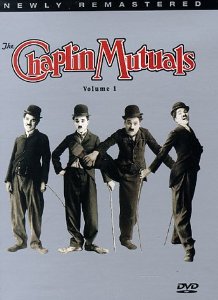
TCM1
The Chaplin Mutuals, Volume 1 – The Chaplin Mutuals is a worthy collection of Chaplin films from 1916 and 1917, many of which were made with Edna Purviance, and her first collaboration with Chaplin was in his second Mutual film, A Night Out; unfortunately, they’re shown out of order, so first up we get The Immigrant and The Adventurer, the last two films that Chaplin did for Mutual. Sadly, the DVD doesn’t come with any extras, documentary material, etc that other Chaplin DVDs include.
The Immigrant shows a fair amount of on-the-boat scenes, with some funny situations, like two people eating from the same bowl of soup that slides back and forth as the boat rocks in the waves. There’s also a great scene of Chaplin leaning over the ledge, seemingly in the act of throwing up – he’s actually fishing and he’s caught one (reminds of other “behind the back” scenes that Chaplin does, like the first scene of Tillie’s Fractured Romance, and the drunk of The Idle Class. Nice. A funny hiccup sequence experiments in soundtrack work. There’s some drama with the mother of the girl he’s fallen in love with – first she’s robbed, then she dies. The movie ends with a strange dinner scene, and Charlie forcing the girl to marry him!!
The Adventurer has Chaplin as an escaped convict, great scenes at the beach as he evades the cops by sliding through their legs, total cat and mouse stuff. In fact, we first see him coming up out of the sand! There’s a funny swimming rescue, where we get to see a muscular Charlie Chaplin. Later on, a funny gag with Chaplin nearly betrayed by a Wanted poster published in the daily paper – he covers for himself by drawing a beard and long hair onto his picture (the Simpsons ripped off this gag somewhat in The Simpsons Movie). Lots of drinkin’ and kickin’ and chasin’. Huge lady dancing with shrimpy man. Ice cream falls down Chaplin’s pants, then down a woman’s dress – hilarious!! The ending foreshadows the end of Monsieur Verdoux.
The Cure includes plenty of nutty bathhouse posing, and a room of heavily bearded men! Chaplin himself goes in drag as one of the harridans (as seen in A Busy Day). Funny Turkish attack massage going on here. Severe stretching – everyone’s drunk!!
Easy Street has Chaplin as a Keystone Cop. There’s lots of fighting, and we even see a junkie with a needle! Social commentary aplenty, but also lots of gags. Hooray for Charlie Chaplin!
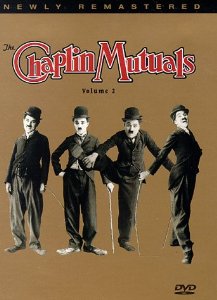
TCM2
The Chaplin Mutuals, Volume 2 – The Chaplin Mutuals is a worthy collection of Chaplin films from 1916 and 1917, many of which were made with Edna Purviance, and her first collaboration with Chaplin was in his second Mutual film, A Night Out; unfortunately, they’re shown out of order, so first up we get The Immigrant and The Adventurer, the last two films that Chaplin did for Mutual. Sadly, the DVD doesn’t come with any extras, documentary material, etc that other Chaplin DVDs include.
The Fireman
The Vagabond
The Count
Behind The Screen
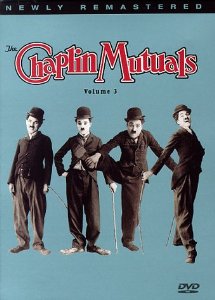
TCM3
The Chaplin Mutuals, Volume 3 – The Chaplin Mutuals is a worthy collection of Chaplin films from 1916 and 1917, many of which were made with Edna Purviance, and her first collaboration with Chaplin was in his second Mutual film, A Night Out; unfortunately, they’re shown out of order, and the DVD doesn’t come with any extras, documentary material, etc that other Chaplin DVDs include.
One AM shows a rich lush, Chaplin, coming home wasted, and battling the objects in his enormous house (which is also oddly dangerous – the clock has a huge pendulum that swings across the doorway to his bedroom!!). There’s an elusive key, a fishbowl to step in, carpets to slide around on, stuffed animals to wrestle with. He throws his hat onto an ostrich’s head, there are dead animals everywhere! Battles with the table, stairs, bed and shower!
The Pawn Shop has employee Chaplin feather dusting everything, fighting with clerk and ladder, a sob story of a guy selling a ring (then producing a huge wad of cash to make change with), and the story of the guy trying to sell a clock that Chaplin destroys as he inspects it. “Sorry, can’t take it – it’s broken!” Saves the day in the end, though.
The Floor Walker in a store where everybody’s blatantly shoplifting! Mirror scene with crook Chaplin, weird detective lady, old bugle man, garish costumes!! Spondulicks Forever! Big money flying around. Running down the up escalator. Ending doesn’t make sense, though.
The Rink has loads of time on the ice, he gives her a card, Sir Cecil Seltzer COD, time for a party!!
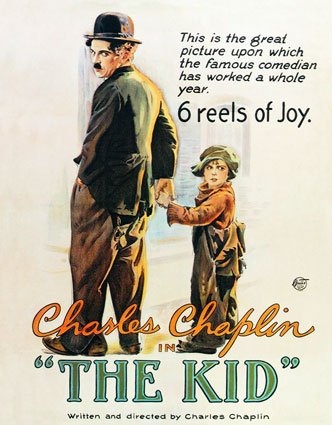
TK
The Kid, 1921 – The Kid is a stirring film about the Tramp discovering an abandoned baby boy, and raising him to the age of five, which is when the real story begins. There are great scenes of the pair living together as chums and having a nice time, working a broken window racket (the Kid breaks them, the Tramp offers to repair them), and the heartbreaking moment when the orphanage comes to claim the Kid. Then there’s also a pretty funny fight scene, and a completely off-the-wall dream sequence – this film has it all! Not one of the funniest Chaplin films, but it sure has lots of heart!
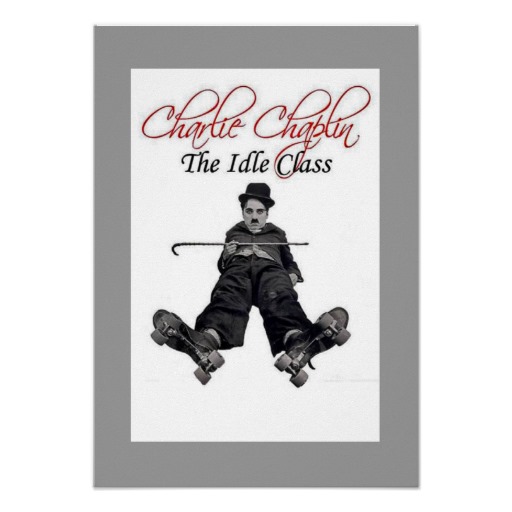
TIC
The Idle Class, 1921 – This is probably one of the funnier Chaplin films, with The Tramp rolling into town to vacation with the wealthy classes, but on a shoestring budget. He also plays his lookalike, a young millionaire drunk whose wife is ready to leave him. Plenty of funny scenes here, with the young drunk trying to get to his appointments on time, absent-mindedly (or drunkenly, or hangover-edly) leaving his hotel room without his pants on, then being covered up at opportune times (The Simpsons ripped this off in Bart’s naked scene ). There’s a fantastic scene when the young millionaire, think that his wife has left him, looks at her portrait and seems to be weeping, but really he’s mixing himself some strong drinks. Later on he’s trapped in a suit of armor, and can’t drink! The Tramp has a cool scene where he fantasizes he saves a beautiful girl from a runaway horse – sensational! But, by the end of the movie, everything’s fixed up and everyone is happy – kick in the butt!!
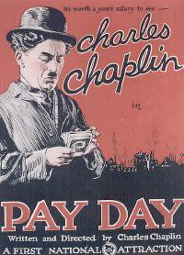
CPD
Pay Day, 1922 – A funny two-reeler, showing our henpecked little tramp making do at the construction site job, getting gyped on wages, turning most of his money over to his wife, and then going out on the town, getting drunk with his “bachelor” friends (never saw such long beards in all my live long day), trying to get a ride home, then dealing with his wife in the morning – no time to sleep, not even in a tub full of water, got to get to work!
Great backwards bricklaying scene, funny elevator food scene that anticipates the elevator scene in City Lights. “Sweet Adeline” scene, which anticipates sound (do they expect the audience to sing along? what if they did?), and amazingly crowded streetcars (is it India, or is it Los Angeles?).
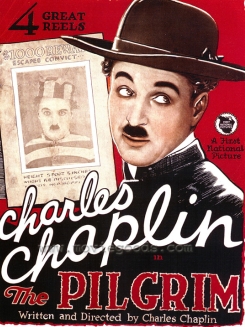
TP
The Pilgrim, 1923 – A nice little 45-minute bit, with Chaplin less tramp-like than in other films – here he’s an ex-convict, escaped from prison, arriving in a small town and mistaken for the pastor. Much of the comedy derives from the fact that he knows nothing of Christianity, and is unfamiliar with the duties of a pastor. There’s a pretty hilarious scene when he pantomimes a sermon about David and Goliath, and another one when families are gathered and one little kid begins whalloping all of the adults, ha ha ha haaa…

AKINY AWOP
A Woman Of Paris, 1923 – A very nice little drama film, in black and white, silent, full of drama, and only subtle pieces of comedy here and there (the woman using the saxophone as an ashtray, the wild parties with wrapped-up stripper mummies get guys to “unwind” them, to the amazement of newly-awoken drunks, etc). We see drama in the quiet village, people at odds, families torn apart, a mistress in Paris, and all sorts of shenanigans. We see the return of true love, and all that’s wonderful and frightening – attempted murder, suicide, over-wrought emotions, like passion, redemption, and true regret.
World-famous since 1914, Chaplin here took a chance by directing something that was not a comedy, and which he did not even appear in. He had to prep the public mightily on this, as it was completely counter to what they demanded, which is more and more of the Little Tramp. In a way, Chaplin had disdain of his audience and maybe too much regard for his artistic talents, but to watch it today is truly fascinating, and there are many, many great scenes.
In some ways, this was his first feature, after a career of nearly 10 years making short films; when it failed in 1923 he left it for over 25 years, then gave it a new score that he himself had composed in 1975, one year before he died; at age 86, that was his last finished work, after nearly 75 years in show business. Wow!!
This film is often packaged together with Chaplin’s A King In New York, a film which bears absolutely not a single connection to this film at all. Oh well, such are the absurdities of life…

CCTGR
The Gold Rush, 1925 – A classic Chaplin masterpiece that contains both the shoe-eating incident (inspired by a true story) and the dancing dinner rolls-on-forks scene (inspired by Fatty Arbuckle, but improved upon by Chaplin), the film is full of funny scenes, like Charlie oblivious to being followed by a bear, the cane-in-the-snow scene, and masterpieces of physical comedy like the windy doorway, and the teetering house (and its narrow escape). Big Jim hallucinating and seeing Charlie as a man-sized chicken is also sheer genius. There’s still a scary moment when Black Larsen kills two men in cold blood, but also some sexy romancing (and, in one of the versions of the film, a long lingering kiss).
This DVD comes with two versions of the movie, the original 1925 release, and a 1942 re-release version that is narrated by Chaplin and has the scene description cards removed (unnecessary). It’s certainly a strange format, but interesting enough given that it’s Chaplin’s own voice. Chaplin also wrote an original soundtrack for this version – talk about attention to detail! Funny dialogue works its way in, like “I’m going away, and when I return I shall come back,” and “I said don’t breathe, stupid.” Funny how Big Jim looks like Peter Grant, the manager of Led Zeppelin.
On top of the two versions of the film, the DVD contains many bonus features such as a five-minute intro, another episode of “Chaplin Today” (27 minutes) trailers (8:46), and 25 posters. The intro explains how the shoe-eating story was inspired by the tale of the Donner party disaster in the Sierra Nevada mountains, when travelers were trapped by the snow and survived through cannibalism and eating their moccasins. We also get a scene of Mary Pickford recounting in 1965 how Chaplin had visited her and Douglas Fairbanks at their home Pickfair, and had looked at 3-D stereoscopic images of the Gold Rush and seen the incredible images of the winter queue at Chilkoot Pass. We also get scenes of Lita Gray talking about Chaplin in 1980, discussing his directorial style. This was the first film Chaplin started with a fully-developed script, something he wouldn’t do again until 1947 and Monsieur Verdoux. He cast Lillita McMurray, who was also in The Kid, now 16, and she became his lover – and was soon pregnant. Renamed Lita Gray, both were miserable in the marriage; Lita was replaced in the film by Georgia Hale, and production dragged on. The Chilkoot Pass scene was reproduced in the Sierra Nevada mountains by creating in mid-winter a 700 metre path at 3,300 metres, using 600 tramps brought in from Sacramento as extras. Chaplin intended to do the whole film there, but it was difficult to shoot scenes there (only a few made it into the film, like Big Jim chasing the Little Tramp around in the snow), so they reproduced Alaska on the United Artists lot in Los Angeles using a backlot, a constructed mountain scene, and 100 barrels of flower…
The film was a huge success, with some audiences demanding an encore of the dinner rolls dance scene. Imagine something like that happening today!!
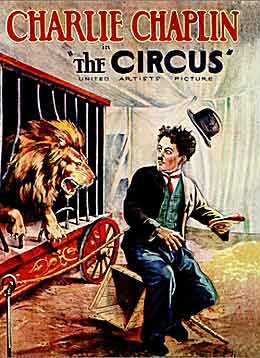
TC
The Circus, 1928 – Chaplin’s third United Artists feature film after A Woman Of Paris and The Gold Rush is perhaps one of his less memorable films, but it is still a good one, with a beautiful opening scene of a girl on a trapeze, which Wim Wenders probably had in mind when he did a similar scene in Wings Of Desire; the opening scene also has a pretty song sun by Chaplin himself, with very nice lyrics. Most of the biggest laughs right up front, including a funny scene where the Tramp is mistaken for a pickpocketer, and all sorts of nutty run-from-the-law type situations, including a nutty chase through a hall of mirrors, and the Tramp imitating an automaton to evade detection. A room of sad clowns. A funny audition scene where the Tramp improves each of the standard comedy scenes he is in through accidents and improvisations… but the circus boss is too blind to see it. We get a scene of Professor Bosco (who appears in many Chaplin pieces, sometimes played by Chaplin himself, such as in his flea circus short). There’s a funny scene in a lion’s cage, with a tiger thrown in to boot (hard to believe such a valuable performer such as Chaplin actually would have stepped into the den like that). There’s even some funny dialogue.
I’ll pay you sixty. No – I’ll double it!!
I won’t settle for anything less than a hundred.
There’s an inventive scene when the Tramp fantasizes about beating up a romantic rival, his ghost stepping out of his body and doing the deed. A great finale with Charlie on the high rope, amazing, and then some sort of ironic, moralistic, all-too-neat happy ending to cap it off.
Some items that are on the proper Chaplin Collection that I would like to check out eventually are:
‘Chaplin Today: The Circus,’ documentary by Francois Ede
Deleted 10-minute sequence ‘October 7-13, 1926,’
Outtakes from a week of shooting
Three home movies from the archives of Lord Louis Mountbatten
‘The Hollywood Premiere (1928),’ Reportage on the L.A. premiere
‘Camera A, Camera B,’ shots made simultaneously from the two cameras used
3-D Test footage by Roland Totheroh
Excerpts from ‘Circus Day’ with Jackie Coogan
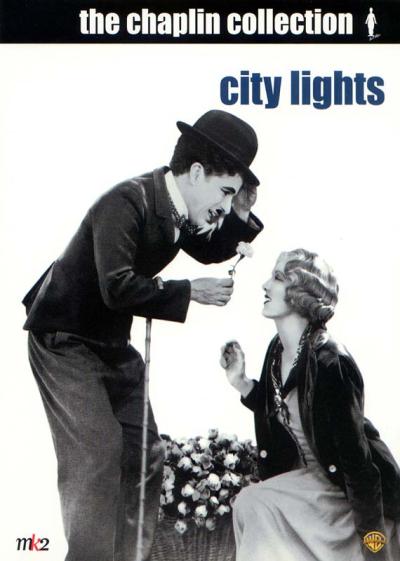
CCC-CL
City Lights, 1931 – A film about the Little Tramp being mistaken as a rich man by a blind flower girl, City Lights contains some great moments as we witness in pantomime the tramp’s growing love for the beautiful blind girl, and his strange misadventures with a suicidal millionaire in the go-go years just prior to the Great Depression (which, over the years, gave way to the important concepts of Modern Times and The Great Dictator).
The disc contains a great list of extras, including a documentary about the film, which gives lots of background, explaining that it’s the longest, hardest shoot Chaplin had done so far – 180 days of filming, with agonizing over the first scene when Chaplin meets the blind flower girl (300 takes). The film had evolved from a concept of Chaplin being the blind one, trying to figure out ways to prevent his child from learning about this terrible handicap, before he landed on the concept that he wanted. Interesting to know that Chaplin and his leading lady, socialite divorcee newcomer Virginia Cherrill, didn’t get along, and he considered her an amateur (she said “I didn’t like Charlie and Charlie didn’t like me”), although he still considered scenes from this movie among his best. The film was troubled by the recent popularity of talking pictures – Chaplin had enjoyed making silent “pantomime” films that could attract a global audience as they were easy to understand, and didn’t need to go through expensive translation and dubbing, and he wasn’t ready for a new model just yet. Well… he compromised by making a film that had a soundtrack that he had written, which also included sound effects (great solution – the early scenes where music mimics the pompous speechifying of dignitaries at the dedication of the new monument, or the scene when Charlie swallows a whistle). The film was, of course, a great success, and Einstein was his guest at the New York premiere, George Bernard Shaw his guest at the London premiere.
Among the extras there’s another short film, Chaplin Today, which provides an interview with Peter Lord, one of the guys behind the Wallace And Gromit films and Aardman Studios (nice guitar shirt, Peter). Lord explains that he sympathises with the pantomime situation, as he had gotten his start as an animator producing films for deaf children, and he relates to the full physical humour, as he learns to use the facial expressions, the tilt of shoulders, hips, weight. There’s some background to City Lights – in 1928, the cities were heartless, and we had the Wall Street boom. Lord refers to wild animation from that era, with Chaplin interacting with Felix The Cat, and even Walt Disney including him in a weird bit of early bubble-world animation. We see the rehearsal of the sidewalk elevator scene, with Charlie dressed up quite poshly, and are reminded that Chaplin owned his own studio and had total freedom to go way over budget and schedule – it was his money he was spending, not somebody else’s.
There’s a great outtake that shows the Little Tramp’s misadventure with a wood wedge – despite the simple concept, it goes on for seven minutes, with Charlie getting agitated trying to get the wood wedge to drop, he interacts with a strange slackjaw kid who chews an apple and spits pulp at Charlie, then ladies come along, then a window dresser observes what he’s doing and starts yelling at him through the glass (their inability to understand each other mimics the whole silent movie experience, ha ha ha); the window dresser gets in trouble as the distraction causes him to stick a pin in his assistant’s butt). Police come along, and that’s it!
We also get to see the screen test that Chaplin did with Georgia Hale, his leading lady from The Gold Rush, who he wanted to bring in to replace Virginia Cherrill, whom he didn’t get along with at all (but there was too much film in the can, it didn’t make sense – good thing, too, because Virginia Cherrill is amazing!!). The screen test contains a few throwaway shots of Asian guys mugging.
Another short outtake shows Chaplin dressed as a prince for a “dream prince” sequence that the blind girl was supposed to have that was never used.
Another private film shows Chaplin goofing around with boxing stars of his day, pulling off little boxing skits (and this film contains one of his most famous boxing scenes!). He’s seen fighting Harry Mansel, mugging in his Tramp costume, barefoot, then fighting Benny Leonard, but now dressed as an English gentleman.
There’s footage of a visit from Winston Churchill (and it is here that we notice what a very big head Chaplin had, on such a little body). All those fine gentlemen smoking their cigars. There’s a documentary of Chaplin in Vienna, being mobbed at the train station before proceeding to record a brief “guten Tag” for his first spoken appearance. Crazy riot! Finally, there’s a great 8-minute clip of his visit to Bali with boats coming out to greet the visitors, bare-chested Bali babes, and Borobudur from nearby Eastern Java. Scenes from a train, Charlie feeding the wild monkeys, a Balinese dance with flashing kris swords and child dancers. Charlie dancing to a gamelan orchesttra. There’s a clip of The Champion, a 1915 short of him fighting in the ring (precursor to the fight scene in City Lights), then trailers in English, French and German, where it’s mentioned that this is “ein ewig Junger Film“, perhaps a sly reference to “der Ewige Jude“, which featured shots of Chaplin’s 1931 visit to Berlin. There’s a photo gallery, and then 27 film posters.

CCMT
Modern Times, 1936 – There’s something ironic about watching a film called “Modern Times” in 2013, when it was in fact filmed nearly 80 years ago (and for us it’s an odd choice for our first Chaplin film, come to think of it…). It’s also ironic that it was still a silent film, despite talking movies having already been around for 10 years. But the film is still an amazing piece of social commentary, combining strong social and political commentary around the central theme of humanity, and giving a last hurrah for Chaplin’s Little Tramp character, who is retired here (although the Jewish barber from Chaplin’s next film, The Great Dictator, is basically the same character), fading into the sunset, having for the first time been heard as well as seen (in the film’s famous nonsense song – Léo Daniderff’s comical song Je cherche après Titine, which Chaplin sings in jibberish – we still don’t truly hear him talking). But with this film, Chaplin was indeed getting with the times, and it was his last true silent film – his next film, The Great Dictator, was a transition film in that it was a talkie, but it was also spoken largely in jibberish (he probably still wasn’t comfortable with the idea of being judged as a proper talking actor and competing with the likes of Orson Welles and Clark Gable). His final four films were all talkies.
Chaplin made the film after taking an unprecedented five years off between his previous film (City Lights) and this one. During that time he travelled the world, meeting Mahatma Ghandi, Albert Einstein and HG Wells and putting together big ideas, which resulted in the development of economic theories that shared concepts with communism, all ideas that came from sympathies and associations with controversial thinkers and which would land him in hot water later in life (in 1957 he was barred from re-entry in the US, his new film Limelight was suppressed, and he lived the rest of his life outside of the US, rarely ever to return, despite having made his career and fortune there, setting up companies and employing thousands).
The film starts off with an interesting scene of workers being hoarded into the factories, followed quickly of a scene of sheep being hoarded from one pen into another (and, if we look carefully, we see a black sheep among them, ha ha ha), before the entrance of the Little Tramp, on his way to work. The film has three distinct areas:
- working in the factory
- in and out of jail
- love
The film takes on several themes, including drug use (cocaine), the inhumanity of the industrial age, police discrimination and other post-Depression era brutality, wage slavery and inhumanity, all of which can be overcome by indomitable free spiritedness. Yay! By the end of the movie, there is no more steam for social commentary, though, and the tale revolves around the Little Tramp and his new girlfriend, the “gamine” (which, by the way, means “a girl with mischievous or boyish charm” – not a commonly-used word any more, I had to look it up!). This is where we get the amazing blind roller skating scene, as well as the beautiful and hilarious nonsense song. The gamine, of course, is played by Paulette Goddard, Chaplin’s off-screen lover at the time as well, and they go off into the sunset together to live happily ever after, apparently forgetting the Gamine’s two younger sisters, whom she had been supporting early in the film before the death of their father.
The scenes and stunts are hilarious beginning to end, and we could hardly stop laughing scene after scene. Chaplin was a real genius of physical comedy. I can hardly describe the hilarity any more than I already have, it just needs to be seen to be believed.
The bonus features are great, and there’s probably as much bonus material as there is original film!
A 30-minute documentary explains how Chaplin was living in an era of mass unemployment and the rise of industrialization. He did an 18-month tour of the world, where he was horrified by the rise of nationalism in Europe, while at the same time developing economic theories of redistributing both wealth and work. It mentions, and shows stills from, the original ending, which showed the Little Tramp going off into the sunset alone after the gamine enters a convent to become a nun (?!?!). We learn that talking films had been around for a decade, but Chaplin still wasn’t ready to do one, although he had developed a talking script that was later abandoned. This film marks the only time that the Little Tramp’s voice is heard, although Chaplin’s voice had been heard by the public speaking in German in Vienna into a short recording device. Modern Times was the last great silent film to come out of Hollywood. As bonus materials we also look over the shoulder of Philippe Truffault and Jean-Pierre Dardenne as they discuss the film. They note that there’s always food in Chaplin’s films, and how the film is a documentary of the times, going all the way to the shack and shanty-town. Industrialisation had brought the cost of a Model T Ford down to $300 from $850, but there were social growing pains. And while voices can be heard speaking in the film in parts, they are always through a machine of sorts – a recording device, in the case of the hilarious feeding machine demonstration (there’s that sheep-herding thing again), a security screen, an intercom. We see a great outtake of Chaplin interacting with a stern traffic cop at one road crossing. We see the cool opening animation of TOBIS studio, with the rooster crapping out the “I” into “TOB S” (who came up with this stuff?? The sample here shows a later version of the same thing, with the rooster’s egg forming the “I” – since when do roosters lay eggs?). Great photo collections show the factory, from jail to paradise, factories re-open, back again, outtakes from the department store silverware robbery scene, soldiers, the gamine’s nun scene), set and production sketches and photos, search for locations, and Paulette Goddard’s publicity shots. There are also several documentaries: Behind The Scenes In The Machine Age (1931), Symphony In F (1940), Liberace’s “Smile” (1956) which was based on Chaplin’s score for the film, and For The First Time (1967).
Behind The Scenes In The Machine Age is a film created by the Department of Labor of the US government showing how industrialisation has robbed men and women of jobs, how it has created labour efficiencies, and how job efficiencies still need to be created, even as the enforcement of good conditions for workers is being promoted. Women, Waste, Bureau, Jobs, Rhymes, Silk Hose, Lollipops, Crackers, Cereals, Bandages, Sheets, Book, Typewriters, Cigars, Cushions, Telephones, Track. It goes on in silence for over 42 minutes. Printing – the hand press versus the mechanical press. Scenes of women working silk hose machines from roller machines, loading 1931 boxes of Mars bars, wrapping lollipops, packing 1931 boxes of Corn Flakes!! Shows entire production process!! Shows girls “building” books, folio by folio. Automatic typewriters. Symphony In F shows the production of a car, from the arrival of crude rubber to the creation of tires to the production of a car, with a special event showing the creation of the 28 millionth Ford. The V8 mark turns into a weird little animated V8 boy. For The First Time, in 1967, is a Cuban documentary that shows a mobile film crew taking their mobile movie experience into the mountains to show some people their first film – which is Modern Times. Wow!! There’s a cool surf guitar intro, we meet the passionate projectionists, and then we meet the villagers. “I have no hobbies, I never go out. There’s no place to go, nothing to do.” “I have 12 children, and who knows how many grandchildren. Only God knows.” The previous government didn’t allow movies.
Meanwhile, here’s Liberace’s “Smile”:
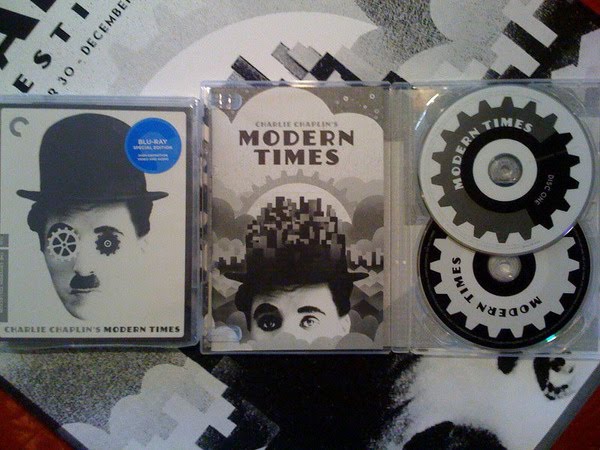
CCCCMT
Modern Times, the Criterion Collection edition – Two discs, the first one containing the film itself alongside commentary from David Robinson (more on that later) and a few bonus features, and the second one containing more bonus features.
The film is the same one as reviewed above, containing also a 16-minute documentary containing plenty of production shots from the creation of the film itself, giving the background of the film. Another 20 minute documentary covers production items, including both visual effects and sound effects, the latter of which were employed for the first time in this film in lieu of regular dialogue (talkies had been coming out for 10 years at that point, but Chaplin didn’t use the soundtrack of Modern Times for dialogue, leaving it mainly for the music). There’s a fascinating breakdown of the feeding machine scene, as well as the glass plate work done on the skating rink scene. Another 15 minute documentary covers the various locations around Hollywood’s commercial district that Chaplin used for this film and other early movies, even going so far as to mention other spots that Buster Keaton and Harold Lloyd had used in the same neighborhood. Shows pictures of existing buildings, especially factories. Silent features used more location shots than talkies as they needn’t concern themselves about setting up sound equipment, and they didn’t fear ambient noise. Then there’s a 16-minute interview with David Raskin discussing the score. We also get nine minutes of pure soundtrack (from the factory scene) without sound effects as a little bonus. The “Two Bits” section contains the gibberish song with the final verse added in (it’s a nice little thing, now 4:10 in length), while we also get the “Crossing The Street” skit that was not used in the film (there were other unused scenes, including extended drunken department store scenes (stealing silverware), and the infamous original ending (the gamin as a nun), but those are lost to time. Finally, there are three trailers: one in English (2:10), one in French (2:00), and one in German featuring film critic Karsten Peters, for the 1972 reissue. On the second disc we get “All At Sea”, an 18-minte short film made by journalist Alastair Cooke during a weekend getaway to Catalina Island on Chaplin’s boat Panacea. Lots of goofy mugging, and Charlie playing as Pan while we see the “Pan” part of Panacea framed. Some shark hunting, some shots of a beautiful young Paulette Goddard, shots of the Terminal Island boat yard area near where some scene from Modern Times were shot, even the port bridge. Nice. Cooke’s daughter also speaks in an interview about the circumstances of the discovery of the old reels, and she gives some background to Cooke’s and Chaplin’s friendship, which didn’t last particularly long. Then we get “The Rink”, a hilarious Mutual film of 25 minutes in length that gets thrown in due to its rink shots, and Charlie’s waitering and kitchen shots, that includes a much more mischievous and violent Charlie. We also get “For The First TIme”, the film about playing Modern Times for rural Cubans in 1968, as well as Chaplin Today, 26:00, featuring Philippe Truffault and Jean-Pierre Dardenne talking about the film.
David Robinson’s commentary is okay, although there are plenty of areas where he doesn’t seem to know what to talk about, or he goes over details that anyone would probably already know about Chaplin – how he’d been exiled from the US from the 1950s, only returning once more in his life, etc. But some of his observations are interesting – he notes that Modern Times is chronologically mid-point in his career as a performer, and how Alan Garcia (the factory boss) had been in practically each of his films since The Idle Class, and it is his voice that is the first one ever heard in a Chaplin film. Robinson gives interesting bits of info on the bit actors in the film such as the Gamin’s father, the burly factory operator Sammy Stein – one of the first characters to appear in Modern Times, who was also a football player and a wrestler – or the pastor’s prudish wife Myra McKinney, whose screen debut it was but who then went on to be in 100 films. Apparently Chaplin had intended Modern Times to be a talkie, and he had filmed most of it in sequence, something rare for a Chaplin film. The feeding machine took seven days to film, but the scene where he winds through the gears only a day (must have been uncomfortable). The Gamin only enters the film after two reels, and only meets Chaplin halfway through the film. Robinson then gives us a strange discussion on whether to write “gamin” or “gamine” for Paulette Goddard’s character (“I hope this isn’t pedantic, but we have to decide on something”). A note on the remarkable music, he explains how David Raskin lost 25 pounds during the project, and was often so exhausted that he slept on the floor of the recording studio, and how the style and feeling of the “Smile” theme is from Puccini. Robinson notes how Michael Jackson loved it and recorded a version that was suppressed. Also, interesting how the gamin picks up a Mickey Mouse doll in the department store, at that time the only rival Chaplin had for the public’s interest. Several of the production people were involved with James Whales’ Frankenstein. Robinson also explains the original intention of how to end the film.
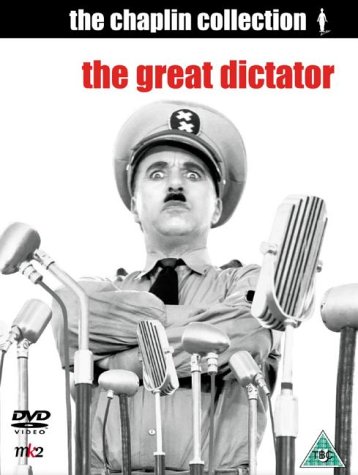
TGC
The Great Dictator, 1940 – The best scenes in the film are all at the beginning – the Jewish Barber (The Little Tramp) fights World War I with Big Bertha, flying a plane upside down, before entering a hospital for a decade or more. Well! In the meantime, Hitler has risen, Jews are on the hate list, and he’s oblivious to it all. Chaplin does a great job showing the villainy of Adenoid “Adolf Hitler” Hynkel, and making fun of his Germanisms, although the dialogue is often a bit dull (not enough physical humour – what’ s Chaplin going to make of the sound age? Will he survive? Well, we will later see that he does… sort of…). Turns applause on and off. Even the microphones react to his spit!! Great gags around the bulletproof silk, the parachute hat. Funny to see him giving Paulette a shave!! Bouncing the world around, twirling it on his finger, as the lyrical music plays – beautiful! Portrait and sculpture posing. Shaving to the tune of the Hungarian Rhapsody. “Peace is declared.” Great train station monument clock with Hynkel’s pose next to it.

CC-DGD

lady shave
The DVD comes with a full set of great bonus materials, including a 55-minute documentary called The Tramp And The Dictator, showing how Charlie faced off against the monster that he had strange parallels with – Chaplin and Hitler were born only four days apart into middle class families, with Chaplin the elder, and both experienced poverty before their rises to tremendous power and influence. The narrators describe both of their lives, showing that Chaplin tasted success earlier than Hitler, whose patience was “rewarded” with unprecedented levels of power and the capacity to do evil on a totally new scale. The documentary makers hired Kenneth Branagh as the narrator, and he gets into some nonsense about Chaplin using the power of laughs to take on the monster (sticks and stones…), nullifying him by refusing to take him seriously (please!). They gave some perspective of the times, explaining that without the crash of 1929 Hitler could never have reached power, as it brought chaos back to Germany, and that “Mussolini was particularly admired by businessmen”, who liked his ability to whip things into shape and make the trains run on time (always more important than human rights, of course). Chaplin’s son explained that he and his father would often go to a newsreel-only cinema (such things existed in those days!!) and just watch the news, and he was fascinated by Hitler, who he considered the greatest actor he’d ever seen, according to Sidney Lumet. He went to Berlin in 1931, got a great welcome; the Nazis thought that he was a Jew, an “accusation” he stubbornly refused to deny (possibly out of solidarity with the Jewish people – after all, “anyone funny was Jewish”, according to Lumet). Chaplin’s visit is included in The Eternal Jew with nasty commentary, and he was also profiled in Die Juden Sehen Dich An (and we get Ivan Montagu talking about how he sent Chaplin a copy). The documentary makers quote Reinhard Spritzy, who is described as being part of Hitler’s inner circle (there’s not a lot of information about Spitzy out there), who believed with certainty that Hitler would have seen The Great Dictator, as he’d have seen all of Chaplin’s films (official records show that Hitler ordered delivery of the film – twice!). Chaplin also travelled to Venice, but he didn’t meet Mussolini, says Ray Bradbury. The casting of the exuberant Jack Oakey as Benzino Napaloni, Dictator of Bacteria (a take on Benito Mussolini) was a spot of brilliance.
We get interesting historical perspective, such as the thought that Henry Ford – who the film-makers note was anti-Semitic – initially supported Hitler, and at the time there was a German-American Bund which had meetings at Madison Square Gardens with up to 20,000 followers, often making anti-Semitic statements. At the time there were over 100 anti-Semitic journals in the US, including American Gentile, which would run nonsensically threatening headlines like “Jews defile our Christmas”. There were even congressional investigations into the Jewish influence in Hollywood (WHAT!!!); the documentary points out that Hollywood made money in Germany and Italy, and there were occasions when films were censored of their anti-German content, often after being previewed for the German consul (wow – American collaboration with Nazi Germany!). One such film was Blockade, which was critical of the fascist forces in the Spanish civil war (a cause that the Nazis supported) that as such included a nasty closing line by Henry Fonda in defiance of this situation, “Where’s the conscience of the world?!” Charlie Chaplin owned his own studio and self-financed the film, so he didn’t have to worry about as many things as others might have, but there were early indications of resistance from countries like Chaplin’s native UK, which didn’t want to piss off the Nazis. But Chaplin got full support from the President of the US, Franklin Delano Roosevelt, who personally, silently encouraged Chaplin to continue with his film, which began filming six days after World War II started (but, of course, two years before the US entered it). As Chaplin was filming the closing speech the attack on France happened, and by the time that the film was released Hitler’s Blitzkrieg had just been launched – finishing the whole film took 559 days (they even had to rebuild the ghetto set to re-shoot scenes that Chaplin wasn’t happy with)!! The documentary shows scenes from the original ending, which included a folk dance with hundreds of extras (and we get wonderful colour shots of this from private shots taken by Chaplin’s brother Sidney). We also see Chaplin venting on an assistant director. The film opened in the UK, despite the earlier misgivings figures there had about the topic, and it became Chaplin’s biggest-ever money maker, even though it was banned in Europer, some parts of South America, and even Ireland (!!!).
The extra features also shows Sidney Chaplin’s personal colour films: in the first part, The Ballroom, where a girl sticks out her tongue, the camera pans around a lot, that lasts 4.5 minutes. Two minutes of the falling-down-stairs scene, 3.5 minutes of scenes from filming the ghetto, then the World War I reel in its entirety, where we see girls who were visiting the set, and several stage hands, and we see the World War I explosions – Charlie gives extras a pep talk from the Big Bertha prop, lots of laughs (7 minutes).
As a prelude to the barber scenes, we get Charlie The Barber, a short piece of seven minutes that shows Charlie, the worst barber in the world, seating a client in a broken-down barber’s chair, Charlie reads the customer’s newspaper while lathering him, he has a ticky arm, the chair falls apart, the customer is burned, blinded and brutalised. It’s a brilliant skit.
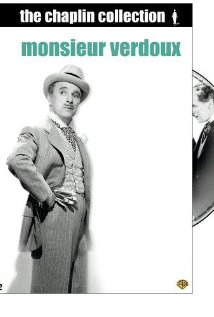
MV
Monsieur Verdoux, 1947 – A Comedy Of Murders. Based on an idea by Orson Welles, for which he was paid $5,000. Wow. The opening scene presages Sunset Boulevard (released in 1950), with its “from the grave” speech opener, and there are times when Chaplin talks directly to the camera (was that a first?). “Lucky Roses”, to be so close to the holder’s lips. Crazy fishing wife – there are crazy bursts of slapstick comedy, intermixed with great cinematography, gorgeous acting, sinister comedy, and philosophizing. Too much commotion, too many questions (Did Verdoux kill his own wife and son? What became of all of his wives? What was he living on?). “I lost my sandwich. A slice of bread with two pieces of meat. Chaplin thought that Monsieur Verdoux was his most brilliant film. Inspired by Henri Desiree Landru, who killed 10 wives, two dogs, and a teenage son of one of his wives, as well as Thomas Wainright, another wife kliler.. “One murder makes a villain, millions a hero. Numbers sanctify.” The shooting of this film was faster and more trouble-free than any of his his previous films, wartime rationing meant no wasting film stock. For the first time, Chaplin shot with a completed working script, a shooting schedule, and scene drawings. He also grew a real mustache for the first time. had to face down hostile journalists at the press conference. “A strange love story that hurts.”
The bonus features are quite skimpy, and we get no interview with surviving cast survivors; in fact, the film and the extras all fit on one disc, compared to other Chaplin Collection films, which go onto two discs (as a newer film, wouldn’t there be more stuff available?). Marilyn Nash, who played The Girl (she’s never named), was still alive in 2003 when this set was released, although she sadly died in 2011, having only made one other film. Claude Chabrol, the director of a film called Landru, which is about the French serial killer that Monsieur Verdoux was based on, has great scene commentary in the film; he died in 2010 at age 80 (both have the same alliterative initials – CC). Notes that in this film Chaplin truly abandons and moves beyond the silent film style, whereas the previous film The Great Dictator melded silent and talkie. Chabrol had made a film about Landru, who he notes “was not a philosopher; Landru was a weirdo!” This is an atheistic film, but the priest is not mocked, rather checkmated and met on equal terms. “Ah, Father, what can I do for you?” The documentary shows long scenes from the film, unlike other such documentaries – is this because there’s less to say about Monsieur Verdoux, compared to the others, or because more “show don’t tell” is required? Chabrol proves a passionate and interested interviewee, he picks scenes apart masterfully, even short ones like Chaplin’s descent of the stairs after a night spent murdering one of his wives. We learn that Chaplin filmed the difficult closing shot first (although we’re never told that it’s a difficult film – how can it be, when we know what he went through to get the right closing shots for City Lights? But hey – that’s, like… his opinion, man…) The film also includes film posters, like all the rest of the DVDs do, but this one is different in that each of the posters includes a radio promo clip (whether they’re connected or not – we hear American clips, whether the accompanying poster is from the US, Czechoslovakia, Japan or the US). Of course, the text can be very corny:
- The most controversial movie of all time!
- A bold comedy that inclues drama, pathos, and even slapstick!
- You’ll scream yourself to death!
- The strangest character of the century!
- The most unusual character ever presented on the screen!
- It is something you have never before seen on the screen. In Monsieur Verdoux there is a peculiar intensity of drama and a more peculiar hysteria of laughter and a strange love story that hurts. With all of its strangeness, there is a pathos and beauty that will haunt you until motion pictures are no longer made.”
Wow.. until motion pictures are no longer made!!!! That’s pretty intense, maaaaaannn!!!

CCL
Limelight, 1952 – A stunning, fantastic film that you can watch over and over again, with beautiful, memorable soundtrack music (also composed by compulsive do-it-all Chaplin). Chaplin is fantastic, his beautiful co-star Claire Bloom less so (a bit hammy as an actress), but the character development is beautiful, the achingly emotional scenes simply stunning, and this film was a welcome new addition to the Chaplin legend after the somewhat uneven (and freakily sinister) Monsieur Verdoux. Chaplin acting like he’s drunk, the trio of kids (his real-life children with Oona O’Neil, including Geraldine Chaplin, who appeared as an adult in Robert Altman’s masterpiece Nashville), the discovery of an attempted suicide, the machinations of the horrible landlady, and the budding relationship; interesting how Chaplin helps the woman, who then helps him (a repeat of a similar device, played to bittersweet effect in Monsieur Verdoux – as is the flirtation with horrible women for ulterior motives).
“Why didn’t you let me die?” “What’s your hurry?” Chaplin cheers the girl up, he acts like a rock or a rose, a bonsai, just as cynical and charming as Monsieur Verdoux; and yet, when she’s re-invigorated, he becomes the one who loses hope (we see the same thing happen in Monsieur Verdoux, but for different, more sinster reasons). Great scenes of Terry falling in love with Calvero, Calvero’s nightmare, his silly comedy act and dull songs (naturally he’ll fail), the deflating of his artistic ego, Terry’s blossoming as the next generation takes over, her psychological impediment – she thinks her legs don’t work, but it’s only in her mind, as we so amply see in her two over-wrought emotional scenes. Great screenplay, although it also has its weird moments. The street musicians who never talk, Calvero’s drinking, and how the landlady warms up after a few drinks. “Beer, Bach and Beethoven.” “Isn’t it a little late for music?” “Not if it’s a nocturne.” Calvero does his version of The Little Tramp. “Ode To A Worm” – is it sexual? “What a sad business, being funny.” “Calvero, I’m walking! I’M WALKING!!!” There’s weird shadows and lighting in the dance audition scene (intentionally bad?). She proposes to him!! Beautiful ballet, silent. Calvero smashes the hysteria out of Terry, she dances like she’s never danced before! Funny scene where the clown Calvero prays, is discovered, tries to cover up – “I lost a button” (ironic after the atheism of Monsieur Verdoux). One short leg act with Buster Keaton is sheer genius, and we hear Buster’s voice!! Amazing. Awesome rock ‘n’ roll tumble, funny splits thing that he does.
Bonus Features: documentary and commentary – Chaplin spent two years on Limelight screenplay, even wrote out a 100,000-word novel called “Footlights”, which indulges in sentimentality for family and the old London stage, and contains also bios of Terry and Calvero. In 1972 Charlie Chaplin won an Oscar for the soundtrack, ironic since the film was subverted upon its release. His family is all over the film – his half-brother plays a clown (and the doctor), so does his son, another son Sidney plays a young romantic rival for Terry’s affections, and his three youngest children also appear (and his young wife Oona is a stand-in for Terry in one of the scenes). When he attended the London premiere, which Princess Margaret attended, he learned that he would not be welcomed back in the US, and would need to apply for re-entry permits, as if he’d never contributed to the US economy, created jobs for Americans, or paid any taxes there. Wow! “That unhappy place,” he called the country, gripped in the anti-communism of the McCarthy era. He re-settled in the UK, his first time back in 21 years (and only the second time back since he initially left) with Oona, the daughter of Eugene O’Neil, with whom he’d eloped in 1942 (and for which her father disowned her). But even if he was shunned in the US, he was openly welcomed in Europe, and he caught up again with Jean Cocteau, whom he’d first met on his trip to Asia in 1936 with Paulette Goddard (that must have been interesting!!). Sidney Chaplain remembers that return in an interview piece, and he talks about going back to places from his childhood. Bernardo Bertolucci remembers. Claire Bloom interviewed, remembering Charlie Chaplin’s white hair, blue eyes, expressive hands. In her actions and wardrobe he incorporates the mother and the women he lost in his life. The tramp was never loved back by his women (at least not until Modern Times), but Terry loves Calvero – everything is stood on its head, and it’s phony; Calvero knows that Terry doesn’t love him truly, and he’s not really wrong either (funny how, in real life, Chaplin had a wife 35 years younger than him – what about that?). Bertolucci is certain that Terry lies when she says she loves him, that it’s staged. Calvero is overwhelmed at the affection he gets at the end of his life – she shows affection, but he feels humiliation. She’d marry him out of pity, and he doesn’t want that. Chaplin fears losing touch with his audience. Violent reation to the character of Monsieur Verdoux. Bertolucci says that, although he doesn’t often cry, “with Limelight, tears flow easily.” In the documentary we see evidence of how the American Legion was trying to get rid of him.
The extras also contains a very nice deleted scene – Charlie Chaplin deals with the landlady, meets the new maid. Too bad it was cut, because in the original film I do wonder how Calvero knows the maid, who appears very suddenly. He then goes to the pub, and meets the one-armed performer he had mentioned earlier, accepts his charity of £20. As another bonus, we get The Professor, a strange story where Chaplin first tries out his trained flea act (Chaplin has a reputation of reviving gags in his later films, and we do see that with the barber clip that inspired the Jewish Barber in The Great Dictator, and now also with this item as well). It’s a funny clip of an old man, sleeping with a pipe. The DVD also contains some great home movies, from the USA in 1950, and from London in 1959, where we see a topless Geraldine. In the garden, on horses, at the beach, on a boat. Shirtless Chaplin – a bit pudgy, actually. Tons of photos, including pictures of the scenes and costumes that didn’t make final cut. There are also 15 film posters.
The Professor:
Incidentally, here’s the great scene of Chaplin and Keaton’s musical performance from the end of Limelight:

AKINY AWOP
A King In New York, 1957 – Oh, wow, this movie is hilarious. Chaplin is a bit more ambiguous than his previous 1950 performance (a masterpiece) as Calvero in Limelight, but much more fun, playful, throwaway, sarcastic, biting, caustic. His first (of two) films in “exile” from his creative home, the United States, this film was shot in Europe (not New York), because he had been hounded out of the US as a communist sympathiser during the McCarthy era witch trials. The film offers some commentary on the situation, a great deal of irony, and many parallels between his real life and the character of King Igor Shahdov. Arriving in New York after being exiled from his country of Estrolia, Shahdov is immediately defrauded by his prime minister, and spends the rest of the movie making TV commercials (for Royal Crown whisky, no less!!), some of which should be failures but only make him more popular! Fame and success come easy for him in the US, and he quickly bores of it, as he sees it below him (true feelings?). He comes into contact with a 10-year-old anarchist, whose parents are Communist schoolteachers, and he’s drawn into the highly politicized world of government witch-hunting, even at one point being charged with seditious activities – they ask him, a deposed king, if he is a communist, which is probably the most hilarious joke in the entire film. The film is full of fantastic comedic scenes, like Chaplin’s grotesque super-smiles, the photographers who ask him for “one serious” (he indulges, sometimes with something Napoleonesque). Chaplin gives his message of love to the United States just as he’s being fingerprinted (WTF?!?). He and his wonderful ambassador Jaume (played to perfection by Oliver Johnston) go out for entertainment, the song mentions “rock ‘n’ roll” (which in 1957, the year rock ‘n’ roll music was emerging, was slang for sex). A great scene of phony trailers, with fantastic dialogue, and great sight gags.
There are great scenes of flirtation over Hamlet, which are overtly sexual:
Ann: – I’d give anything to see your Hamlet.
Shahdov: – Maybe you will one night.
Ann: – Why not tonight?
Shahdov: – Okay, a private performance. “To Be or not to be”….
Ann: – Now!
Shahdov: – You mean here?
Ann: – Why not?
Shahdov: – Oh, no no no…
More of the same in the “I’m Getting Hot” musical number by the girl in the mini-skirt, and there’s the “If only I was 20 years younger.” Chaplin’s bombastic “To be or not to be” recitation from Hamlet is a scream, and the fantastic plastic surgery sequence is also very funny.
Dawn Addams is fantastic as a sexy ad girl Ann Kay. Michael Chaplin is stunning as a 10-year-old anarchist, even if he stumbles over his words at times. His intellectual domination of his dad in the school scene is quite a coup for a child actor, and it’s amusing to watch how he repeats dogmatic cliches that often lack any thread of cohesion (this is clearly a deliberate move by screenwriter Charlie)!
Funny how, for a stretch of the film, Chaplin is an absolute letch, and maybe this is one of the film’s flaws – it’s clear that he’s a different person in different scenes: the king, the magnanimous husband, the letch, the man who is pursuing a pretty girl, and the man who is the subject of a witch hunt/trying to protect one of its victims. But, then again, this is also how Chaplin was used to making films – different reel, different story.
In the (rather abrupt) ending he leaves, a stranger to the US who – whiles beloved there – still prefers to be in Europe. The message is clear; of course, US authorities clamped down on the film in an official quid pro quo, and the film was not shown in the US until 1967. Oh well, Chaplin didn’t need to care – he was rich, he was happy with his new family in Switzerland, and in the end he has been redeemed.
This film is often packaged together with Chaplin’s A Woman Of Paris, a film which bears absolutely not a single connection to this film at all. Oh well, such are the absurdities of life…

ACFHK
A Countess From Hong Kong, 1967 – In Charlie Chaplin’s last film, made when he was 78, Marlon Brando is an oil baron’s son trying to enter politics (this is one of only two films that Chaplin was involved in, but didn’t star in – the other is A Woman Of Paris). He has a night in Hong Kong, his ship departs, and he finds countess Natascha (played by Sophia Loren) stowed away; a “white Russian” cast adrift by the Russian revolution, she forces herself into his life as a tragic, beautiful war refugee.
This is a Chaplin film, and there’s all sorts of comedic situations. But with the screwball romance that was one with the times, this is really more of a Billy Wilder film than a Chaplin film; and given that this is his first attempt to do a colour film, it does look like the cards were stacked against him. The story is a bit flat, with Brando mumbling his way through the drama, and we seldom feel that there’s love growing in him for this nutty chick who’s appeared in his suite. Most of the drama is enacted in Brando’s two-room suite, with Loren scrambling for the toilet every time there’s someone at the door. Some funny scenes include a crazy night of wave-swept storms, and some intermingling with the ship’s passengers, including a strange scene stealing Society Girl, played by former Bond girl Angela Scoular, who talks about the immortality of the soul, and begins phrases with “Daddy says…” Another funny interlude with the batty Miss Gaulswallow, who the hopeful young men on board the ship mistake for Natascha. Chaplin’s son Sydney plays Brando’s business manager Harvey, and his daughter Geraldine is one of the other society girls on the boat (other daughters Josephine and Victoria also turn up). Tippi Hedren shows up as Brandon’s estranged wife, and there’s all sorts of nonsense getting Sofia Loren to marry his butler, Hudson (played masterfully by Patrick Cargill), and Chaplin turns up at age 78 in two scenes, where he’s only seen peering in the door. Excellent cameos, not a great film overall, though.
Another review noted that when Chaplin made this film, he no longer owned his own studio, and he had little of the control he had in earlier days with his other films. The review also pointed out that neither Brando nor Loren were comedic actors, true, true… It’s also a shame that so little of Hong Kong is to be seen in the film, but I guess this only mirrors the Gold Rush, which had only a few scenes at the beginning of the film that were made outside of a Hollywood studio. Oh well…
It’s interesting to learn that Chaplin had initially tried to make this film in 1930 with Paulette Goddard.
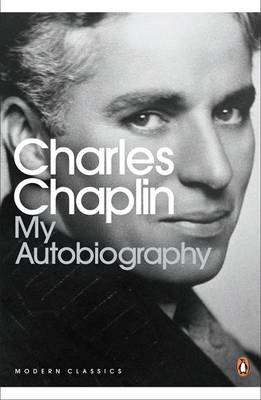
CCMA
My Autobiography, by Charlie Chaplin – Chaplin published his autobiography in 1964 when he was 75 years old, so it contains nearly everything he did in his life, with the exception of “A Countess From Hong Kong”, his final film (he directed Sophia Loren and Marlon Brando and his son Sydney in it, only appearing himself in a very brief cameo). As it’s only about 450 pages long, there’s a whole bunch he skips, including his entire second marriage (he says it’s out of respect to his two sons from that marriage – better read David Robinson’s biography of Chaplin). He also rushes over most of his films and, as with most autobiographies, there are more details about his childhood and the launch of his career than any other part of his life (whole years of his later life seem to go by with no mention, whereas he wrote about 1897 in great detail).
He starts the book writing about his early childhood and living in relative affluence. While his successful vaudeville actor father left the family when he was too young to remember him (although they saw him later in life after he had re-married and fathered a child with his new wife), he does write lovingly about his mother (who never remarried), strong and happy memories, even when his mother’s health began to suffer and she slid into poverty, malnutrition and insanity; in contrast, he doesn’t write very much about his half-brother Sydney (and hardly reveals that Sydney is not his full brother!). There are sad tales of being maltreated by relatives, and of going to the workhouse (an institution set up for the very poor to house them and put them to work) and the three of them being separated. In one case, the mother discharged herself and the boys from the work house for a day, just so that she could see her boys and be with them for a day, then at the end of the day had everyone re-admitted. It was like something straight out of Charles Dickens (who, incidentally, died 20 years before Chaplin was born). It was the three of them against the world, mother repaying for the sins of her youth and escapades in Africa that produced Sydney… who knows?
He also writes of the theatre, and the eccentrics that he met there, or heard about. In one grisly chapter he notes the strange phenomenon of comedic actors being particularly prone to suicide. Chaplin’s own vaudeville actor father, while not suicidal, was prone to drink, and Chaplin writes of his last days, dying of chronic alcoholism at just 37 (Chaplin himself lived to 88). Happily, Chaplin didn’t suffer himself from the disorder of his peer group, like this sad fellow:
Frank Coyne, with whom we played on the same bill, was a gay, bouncy type of comedian, famous for his breezy songs. Off stage he was pleasant and always smiling. But one afternoon, after planning to take a drive with his wife in their pony and trap, he forgot something and told her to wait while he went upstairs. After twenty minutes she went up to see what was causing the delay, and found him in the bathroom on the floor in a pool of blood, a razor in his hand – he had cut his throat, almost decapitating himself.
There was great talent in the theaters of London, and Chaplin tells an amazing tale of a clown who could toss a billiard ball up in the air and let it rest it on a pool cue that he had balanced on his chin, then toss up a second billiard ball and balance it on the first! It took him four years of constant practicing to be able to achieve this. Wow!!
But for someone who grew up in poverty and who was well known for his humanity, Chaplin could be remarkably cruel to those worse off then himself, and maybe a bit snooty as well:
Mother had a saying: “You can always stoop and pick up nothing.” But she herself did not adhere to this adage, and my sense of propriety was often outraged. One day, returning from Brompton Hospital, Mother stopped to upbraid some boys tormenting a derelict woman who was grotesquely ragged and dirty. She had a cropped head, unusual in those days, and the boys were laughing and pushing each other towards her, as if to touch her would contaminate them. The pathetic woman stood like a stag at bay until Mother interfered. Then a look of recognition came over the woman’s face. “Lil,” she said, feebly, referring to Mother’s stage name, “don’t you know me – Eva Lestock?”
Mother recognized her at once, an old friend of her vaudeville days.
I was so embarrassed that I moved on and waited for Mother at the corner. The boys walked past me, smirking and giggling. I was furious. I turned to see what was happening to Mother and, lo, the derelict woman had joined her and both were walking towards me.
Said Mother: “You remember little Charlie?”
“Do I!” said the woman, dolefully. “I’ve held him in my arms many a time when he was a baby.”
The thought was repellent, for the woman looked so filthy and loathsome. And as we walked along, it was embarrassing to see people turn and look at the three of us.
Mother had known her in vaudeville as “the Dashing Eva Lestock”; she was pretty and vivacious then, so Mother told me. The woman said that she had been ill in the hospital, and that since leaving it, she had been sleeping under arches and in Salvation Army shelters.
First Mother sent her to the public baths, then to my horror brought her home to our small garret. Whether it was illness alone that was the cause of he present circumstances, I never knew. What was outrageous was that she slept in Sydney’s armchair bed. However, Mother gave her what clothes she could spare and loaned her a couple of bob. After three days she departed, and that was the last we ever saw or heard of “the Dashing Eva Lestock”!
Of course, later he takes a different tack on poverty, when Somerset Maugham romanticized it,with words like “I have a notion that he suffers from a nostalgia of the slums. The celebrity he enjoys his wealth, imprison him in a way of life in which he finds only constraint. I think he looks back to the freedom of his struggling tough, with its poverty and bitter privation, with a longing which knows it can never be satisfied. To him the streets of southern London are the scene of frolic, gaiety and extravagant adventure… I can imagine him going into his ow house and wondering what on earth he is doing in this strange man’s dwelling.”
Somerset Maugham had met Chaplin, but Chaplin didn’t enjoy this analysis:
This attitude of wanting to make poetry attractive for the other person is annoying. I have yet to know a poor man who has nostalgia for poverty, or who finds freedom in it. Nor could Mr Mauham convince any poor man that celebrity and extreme wealth mean constraint. I find no constraint in wealth – on the contrary I find much freedom in it. I do not think Maugham would ascribe such false notions to any character in his novels – even in the least of them. Such glibness as “the streets of southern London are the scene of frolic gaiety and extravagant adventure” has a tinge of Marie-Antoinette’s airy persiflage.
I found poverty neither attractive nor edifying. It taught me nothing but a distortion of values, an over-rating of the virtues and graces of the rich and the so-called better classes.
Eventually to become rich and successful, he still had his moments of strange pettiness, and seemed to care overly-much about money, as seen in a conversation he had with someone who was as zealous in her religion as his mother was:
“If you had only put your talent in the device of the Lord – think of the thousands of souls you could have saved.”
I smiled. “I may have saved souls, but not money.”
Interestingly, Chaplin writes about one brief interlude in the book when his mother befriended a woman who was a helper in the household of a rich general’s mistress, and how the family used to live there in the countryside and freeload, to the extent that when Charlie likewise befriended a neighborhood boy the kid thought that Chaplin was from a rich family; the family moved away when the stress of living in the shadows became too much for them, so they returned to freedom and poverty, having momentarily tasted the good life. Charlie later ran into the boy in some part of London, causing awkwardness about the rags he was wearing.
Chaplin’s book is full of fanciful, pretentious vocabulary, and he loves bandying about words like legerdemain, rodomontade, sybarite, persiflage, grandiloquent, foru-foru, propinquity, hoydenish and all sorts of other obscure items. I noted several words that I didn’t myself know!
Recounting his school absenteeism and his lack of career options, despite trying out many professions, Chaplin finally tells of his drifting into the theatre, where success came quickly after getting very good reviews. And it is a case like this, when Keystone Films co-owner Mack Sennett saw him portraying a drunk in a traveling Karno revue in the US, that he offered Chaplin a film contract; and it’s true that in his earliest films (and also a later film like Limelight), he played drunks, quite convincingly (he’d seen plenty of that behavior in the UK, and with his own father, and mother-in-law).
He tells of a scene he experienced, which he recreated in Limelight:
The first time I went [to Blackmore's theatrical agency in London], the office was adorned with immaculately-dressed Thespians of both sexes, standing about talking grandiloquently to each other. With trepidation I stood in a far corner near the door, painfully shy, trying to conceal my weather-worn suit and shoes slightly budding at the toes. From the inner office a young clerk sporadically appeared and like a reaper would cut through the Thespian hauteur with the laconic remark: “Nothing for you – or you – or you” – and the office would clear like the emptying of a church.
He’s quite frank about visiting prostitutes:
Through this haze and confusion I lived alone. Whores, sluts and an occasional drinking bout weaved in and out of this period, but neither wine, women nor song held my interest of long.
He also talks about the House Of Nations in Chicago, run by two middle-aged spinsters.
It was notorious for having women of every nationality. Rooms were furnished in every style and decor: Turkish, Japanese, Louis XVI, even an Arab tent. It was the most elaborate establishment in the world, and the most expensive. Millionaires, industrial tycoons, cabinet ministers, senators and judges alike were its customers. Members of a convention usually terminated their concord by taking over the whole establishment for the evening. One wealthy sybarite was known to take up his abode there for three weeks without seeing daylight.
Sounds like he had his youthful fun, and even had groupies:
In each town we would get together in the red-light district, six or more of us. Sometimes we won the affection of the madam of the bordel and she would close up the ‘joint’ for the night and we would take over. Occasionally some of the girls fell for the actors and wold follow them to the next town.
The partying led to some crazy incidents:
Members of the troupe and I occasionally spent a night carousing through the bordellos and doing all the hoydenish things that youth will do. One night, after drinking several absinthes, I got into a fight with an ex-lightweight prize-fighter named Ernie Stone. It started in a restaurant, and after the waiters and the police had separated us, he said: “I’ll see you at the hotel,” where we were both staying. He had the room above me, and at four in the boring I rolled home and knocked at his door.
“Come in,” he said briskly, “and take off your shoes so we won’t make a noise.”
Quietly we stripped to the waist, then faced each other. We hit and ducked for what seemed an interminable length of time. Several times he hit me square on the chin, but to no effect. “I thought you could punch,” I sneered. He made a lunge, missed and smashed his head against the wall, almost knocking himself out. I tried to finish him off, but my punches were weak. I could hit him with impunity, but I had no strength behind my punch. Suddenly, I received a blow full in the mouth which shook my front teeth, and that sobered me up. “Enough,” I said. “I don’t want to lose my teeth.” He came and embraced me, then looked in the mirror: I had cut his face to ribbons. My hands were swollen like boxing gloves, and blood was on the ceiling, on the curtains, and on the walls. How it got there, I do not know.
But before he was successful he had the inevitable struggles. But he viewed them philosophically, with a line I’d like to borrow:
A formidable element in optimism is youth, for it instinctively feels that adversity is pro tem, and that a continual run of ill luck is just as implausible as the straight and narrow path of righteousness. Both eventually must deviate.
With Karno he went to the US, first arriving by steamer in Quebec, then traveling by train to Toronto.
His description of how he developed his identity as the tramp, early on in his career at Keystone, is amazing. He had just been in Making A Living, where he played a sadistic dandy cheating a fellow reporter out of a girl and a story, where he “wore a light frock-coat, a top hat and a handlebar mustache.” Chaplin wasn’t satisfied, not in the least with co-owner Lehrman as director; his rapport with the other owner Sennett was much better, and when Sennett came back to direct another piece, history was made:
I was in my street clothes and had nothing to do, so I stood where Sennett could see me. He was standing with Mabel [Normand, Keystone's star actress], looking into a hotel lobby set, biting the end of a cigar. “We need some gags here,” he said, then turned to me. “Put on a comedy make-up. Anything will do.
I had no idea what make-up to put on. I did not like my get-up as the press reporter. However, on the way to the wardrobe I thought I would dress in baggy pants, big shoes, a cane and a derby hat. I wanted everything a contradiction: the pants baggy, the coat tight, the hat small and the shoes large. I was undecided whether to look old or young, but remembering Sennett had expected me to be a much older man, I added a small mustache, which, I reasoned, would add age without hiding my expression.
I had not idea of the character. But the moment I was dressed, the clothes and the make-up made me feel the person he was. I began to know him, and by the time I walked on to the stage he was fully born. When I confronted Sennett I assumed the character and strutted about, swinging my cane and parading before him. Gags and coedy ideas went racing through my mind.
The secret of Mack Sennett’s success was his enthusiasm. He was a great audience and laughed genuinely at what he thought funny. He stood and giggled until his body began to shake. This encouraged me and I began to explain the character: “you know this fellow is many-sided, a tramp, a gentleman, a poet, a dreamer, a lonely fellow, always hopeful of romance and adventure. He would have you believe he is a scientist, a musician, a duke, a polo player. However, he is not above picking up cigarette-butts, or robbing a baby of its candy. And, of course, if the occasion warrants it, he will kick a lady in the rear – but only in extreme anger!”
The mustache thing is interesting – actors in the Keystone and other silent films in those days tended to favor outrageous mustaches, and there’s one film where Chaplin wears an elaborate forked goatee (!?!?). The toothpick mustache, eventually also favored by Adolf Hitler (who was born only four days after him), made history – and infamy. It can no longer be worn in polite society.
Making that first film, Chaplin noted that a crowd of actors and stage hands gathered and were enjoying the film-making as well, quite a compliment for the young actor’s comedic skills.
That evening I went home on the street-car with one of the small-bit players. Said he: “Boy, you’ve started something; nobody ever got those kinds of laughs on the set before, not even [Keystone star] Ford Sterling – and you should have seen his face watching you, it was a study!”
“Let’s hope they’ll laugh the same way in the theatre,” I said, by way of suppressing my elation.
And his films were popular. Chaplin butted heads with Mabel Normand on one set when he fought with her over her direction (she was inexperienced and making bad decisions), and Sennett came close to firing him… but he changed his mind when he got word that theaters around the US were begging for more Chaplin product, due to its high popularity. Saved by the bell!
Chaplin knew all of the legends, including Rudolph Valentino:
Valentino had an air of sadness. He wore his success gracefully, appearing almost subdued by it. He was intelligent, quiet and without vanity, and had great allure for women, but had little success with them, and those whom he married treated him rather shabbily. Soon after one marriage, his wife started an affair with one of the men in the developing laboratory, with whom she would disappear into the darkroom. No man had greater attraction for women than Valentio; no man was more deceived by them.
He also notes of meeting Franklin D Roosevelt when he was the Assistant Secretary of the Navy. Well!
Chaplin offers interesting angles on life in the film industry in the early 20th century:
Douglas Fairbanks was the first film star to live in Beverly HIlls, and [he] often invited me to stay the week-end with him. At night from my bedroom I would listen to the coyotes howling, packs of them invading the garbage cans. Their howls were eerie, like the pealing of little bells.
While Chaplin doesn’t often discuss his films, he does have a long discussion about The Gold Rush, including a description of what sounds like a very interesting deleted scene:
I was led up many a blind alley, and many amusing sequences were discarded. One was a love scene with an Eskimo girl who teaches the tramp to kiss in Eskimo fashion by rubbing noses together. When he departs in quest of gold, he passionately rubs his nose against hers in a fond farewell. And as he walks away he turns and touches his nose with his middle finger and throws her a last fond kiss, then surrepititiously wipes his finger on his trousers, for he has a bit of a cold. But the Eskimo part was cut out because if conflicted with the more important story of the dance-hall girl.
The idea of inter-racial romance probably also wasn’t so well looked-upon by the studio executives.
Interestingly, Chaplin devotes quite long sections of the book to his interactions with William Randolph Hearst, whom he names as “the personality in my life [who] has made the deepest impression on me.” They were friends, and Hearst often invited him to his parties, as did his mistress Marion Davies, whom Chaplin found “simple an charming” (although this friendship didn’t mean much – she gave him the cold shoulder years later when he was being hounded by the anti-Communist witch hunters of the McCarthy era). He mentions that Hearst had been pro-German up to the start of World War II, and enjoyed an association and friendship with the German Ambassador to the US that “verged on a scandal.” He also interviewed HItler!
Chaplin also describes his first impressions of the images of Hitler making a speech in a series of picture postcards, which he got from Cornelius Vanderbilt, who had written on Hitler’s concentration camps after a visit he’d finagled on some pretext (“his stories of degenerate brutality were so fantastic that few people believed him”):
The face was obscenely comic – a bad imitation of me, with its absurd mustache, unruly, stringy hair and disgusting, thin little mouth. I could not take Hitler seriously. Each postcard showed a different posture of him; one with his hands claw-like haranguing the crowds, another with one arm up and the other down, like a cricketer about to bowl, and another with hands clenched in front of him as though lifting an imaginary dumb-bell. The salute with the hand thrown back over the shoulder, the palm upwards, made me want to put a tray of dirty dishes on it. “This is a nut!” I thought. But when Einstein and Thomas Mann were forced to leave Germany, this face of Hitler was no longer comic but sinister.
Chaplin was friends with Albert Einstein and his wife, and in the book he offers a great rendition of how Einstein came up with his theory of relativity:
At dinner [Mrs Einstein] told me the story of the morning [Einstein] conceived the theory of relativity.
“The Doctor came down in his dressing-gown as usual for breakfast but he hardly touched a thing. I thought something was wrong, so I asked what was troubling him. ‘Darling,’ he said, ‘I have a wonderful idea.’ And after drinking his coffee, he went to the piano and started playing. Now and again he would stop, making a few notes then repeat: ‘I’ve got a wonderful idea, a marvelous idea!’
“I said: ‘Then for goodness’ sake tell me what it is, don’t keep me in suspense.’
“He said: ‘It’s difficult, I still have to work it out’”
She told me he continued playing the piano and making notes for about half an hour, then went upstairs to his study, telling her that he did not wish to be disturbed, and remained there for two weeks. “Each day I sent him up his meals,” she said, “and in the evening he wold walk a little for exercise, then return to his work again.
“Eventually,” she said, “he came down from his study looking very pale. ‘That’s it,’ he told me, wearily putting two sheets of paper on the table. And that was his theory of relativity.”
There are also some funny tales of Einstein’s money matters:
Mrs Einstein tells an interesting story of the Professor’s ignorance of money matters. Princeton University wanted him to join their faculty and wore about terms; the Professor submitted such a modest figure that the heads of Princeton replied that the terms he asked would not be adequate for living in the United States, and that he would requirer at least three times the amount.
…
“You must come to Berlin and visit us,” she said.” We have not a big place – the Professor is not rich although he has access to over a million dollars for his scientific work from the Rockefeller Foundation – but he has never used it.”
…
The most expensive piece of furniture [in their modest little flat in Berlin] was the black piano upon which he made those historical preliminary notes on the fourth dimension. I have often wondered what became of the piano. Possible it is in the Smithsonian Institution or the Metropolitan Museum – possibly used as kindling wood by the Nazis.
Chaplin recounts a very interesting conversation he had with Orson Wells, which led to the screenplay of Monsieur Verdoux:
The repetition of coincidence is worthy of examination, I said, and related a story that happened to me as a boy. I was passing a grocer’s shop in Camberwell Road and noticed the shutters were up, which was unusual. Something prompted me to climb on the window-ledge and look through the diamond hole of the shutter. Inside it was dark and deserted, but the groceries were all there, and there was a large packing-case in the centre of the floor. I jumped from the ledge with a sense of repugnance and went on my way. Soon after, a murder case exploded. Edgar Edwards, an affable old gentleman of sixty-five, had acquired five grocery stores by simply bludgeoning the owners to death with a sash-weight and then taking over their business. In that grocery shop in Camberwell, in that packing-case, were his three last victims, Mr and Mrs Darby and t heir baby.
But Wells would have none of it; he said that it was common-pace in everyone’s life to have many coincidences, and that it proved nothing. That was the end of the discussion, but I could have told him of another experience, of the time when I as a boy stopped at a saloon in the London Bridge Road and asked for a glass of water. A bluff, amiable gentleman with a dark mustache served me. For some reason I could not drink the water. I pretended to, but as soon as the man turned to talk to a customer I put the glass down and left. Two weeks later, George Chapman, proprietor of the Crown public house in the London Bridge Road, was charged with murdering five wives by poisoning them with strychnine. HIs latest victim had been dying in a room above the saloon the day he gave me the glass of water. Both Chapman and Edwards were hanged.
Since I live in Singapore, I was quite interested in Chaplin’s description of a visit here as he passed through on his way to Bali and Japan (where he had an interesting evening with fellow passenger Jean Cocteau – “Mr Cocteau – he say – you are a poet – of zer sunshine – and he is a poet of zer – night.”):
Our next port was Singapore, where we entered the atmosphere of a Chinese willow-pattern plate – banyan trees growing out of the ocean. My outstanding memory of Singapore is of the Chinese actors who performed at the New Word Amusement Park, children who were extraordinarily gifted and well read, for their plays consisted of many Chinese classics by the great Chinese poets. The actors performed on a pagoda in the traditional fashion. The play I saw lasted three nights. The principal actor of the cast, a girl of fifteen, played the prince, and sang in a high, rasping voice. The third night was the final climax. Sometimes it is better not to understand the language, for nothing could had affected me more poignantly than the last act, the ironic tones of the music, the whining strings, the thundering clash of gongs and the piercing, husky voice of the banished young prince crying out in the anguish of a lost soul in lonely spheres as he made his final exit.
Chaplin writes a lot about his time in Bali, visiting Western scholars there to study its music, and he provides descriptions of some of the temple festivals he witnessed. Writing in 1964, Chaplin lamented the lost Bali of his visit:
Bali then was a paradise. Natives worked four months in the rice-fields and devoted the other eight to their art and culture. Entertainment was free all over the island, one village preforming for the other. But now paradise is on the way out. Education has taught them to cover their breasts and forake their pleasure-loving gods for Western ones.
Chaplin’s time in Japan was very chaotic, as he was there in the middle of significant power struggles that dictated the tragic destiny of the nation as the leaders that brought the country to war consolidated their power. One night when Chaplin attends a sumo match (he calls it a Suomi match” – how charming) with the prime minister’s son, the party learns that the prime minister has been assassinated. Horrible!! And in a book called Government By Assassination, published by Knopf, Chaplin learns that there had even been a plot by the prime minister’s assassins to murder Chaplin while he was in Japan to provoke an international reaction! Crazy…
Chaplin knew anyone who was famous and influential, especially in the arts, and he recounts a conversation he had with Rachmaninov.
Someone brought the topic round to religion and I confessed I was not a believer.
Rachmaninov quickly interposed: “But how can you have art without religion?”
I was stumped for a moment. “I don’t think we are talking about the same thing,” I said. “My concept of religion is a belief in a dogma – and art is a feeling more than a belief.”
“So is religion,” he answered. After that I shut up.
Crucial to the Chaplin story is the tale of Chaplin vs US, when the McCarthy anti-Communist witch hunters came after him for slights real or perceived. Eventually, while in London, he found out that he a re-entry pass that he had secured before leaving the US had been revoked, and he “was to be barred form the United States, and that before I could re-enter the country I would have to go before an Immigration Board of Enquiry to answer charges of a political nature and of mural turpitude.” Seems crazy to think now that things like that took place, but even today silly things like this happen to people like Cat Stevens, and others. Chaplin described his feelings on the matter:
Whether I re-entered that unhappy country or not was of little consequence to me. I would like to have told them that the sooner I was rid of that hate-beleaguered atmosphere the better, that I was fed up with America’s insults and moral pomposity, and that the whole subject was damned boring. But everything I possessed was in the States and I was terrified they might find a way of confiscating it. Now I could expect any unscrupulous action from them. So instead I came out with a pompous statement to the effect that I would return and answer their charges, and that my re-entry permit was not a “scrap of paper”, but a document given to me in good faith by the United States Government – blah, blah, blah.
The phrase “that unhappy country” has become somewhat famous.
Luckily Chaplin had been to the bank and signed his American wife power of attorney over his securities, otherwise they could have been trapped in the US. Not a happy thought for someone who had worked hard for his wealth and deserved full access to it.
The years in Europe were happy years, when Chaplin started another family with his young (35 years younger) wife Oona, and he recounts life in Switzerland and buying a massive house in the countrieside there. He also has a great story of meeting Picasso:
Picasso took us to the Left Bank studio which he still uses. As we climbed the stairs, we saw a sign on the door of the apartment below him: “This is not Picasso’s studio – another flight up, please.”
We came upon the most deplorable, barn-like garret, that even Chatterton would have been loth to die in. Hanging from a nail in one rafter was a stark electric bulb, which enabled us to see a rickety old bed and a broken-down stove. Resting against the wall was a pile of old dusty canvases. He picked up one – a Cezanne, and a most beautiful one. He picked up another and another. We must have looked at fifty masterpieces. I was tepted to offer him a round sum for th eliot – just to get rid of the litter. In that Gorki’s “lower depth” was a gold mine.
The book is a masterpiece and full of lots of very interesting details about a truly remarkable life, and we even learn some unpleasant details about his character, whether intended or unintended. Like all autobiographies, a lot of detail has been left out; I’m now looking forward to reading David Robinson’s (who provides an introduction to this edition) acclaimed biography of the man to hopefully fill in the gaps.
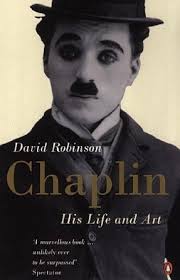
CHLAA
Chaplin – his life and art, by David Robinson – David Robinson’s bio of Chaplin is said to be one of the best. Certainly, there are clips of him reading from his own work in the Chaplin Collection DVDs, and it is this work and Chaplin’s own autobiography that form the basis of Sir Richard Attenborough’s biopic of Chaplin. The book is a huge lug, with 632 regular pages, 45 pages of chronology, info about his life as a touring actor, some Keysone scenarios, a detailed filmography, a who’s who, a bibliography, and an index, plus a few other additional nuggets of appendicised info. There are also tons of pictures, a map of the London of Chaplin’s youth, and complicated family trees. Nice.
The book is interesting, exploring large areas that Chaplin himself didn’t get into, such as his early marriages, the fate of his wives, the fact that he was actually married to Paulette Goddard, which friendships lasted into later life, information about his half-brother Wheeler Dryden, exploration of his films, his film-making processes, his studio life, his working life, his sometimes-difficult relationship with his offspring (or anyone in his life, personal or professional, for that matter), his contrasts, his loneliness, his fickleness, and many other areas. Chaplin also entirely skips his relationship with Pola Negri, which was substantial, and Robinson describes it in great detail, often including public statements that they made! What both books have in common are deep information about his childhood (Robinson seems to reiterate it and offer documentary evidence that Chaplin’s memory was nearly always on the mark), and discussion of his obsessive work ethic and how he always pushed for perfection. It also delves into the lunatics that entered his life, however briefly, before being ejected (and also some non-lunatics, who were similarly ejected). Robinson curiously leaves out several episodes that Chaplin includes, such as his episodes with the wood choppers. But we do get a sense that Robinson is a curious and involved biographer, who had at least met Chaplin face-to-face on occasion, and had the opportunity to interview some of the people in Chaplin’s life.
The book is full of amazing and curious information. It probes the lives of Chaplin’s ancestors going back three generations. Here Robinson notes with some irony that Charlie’s maternal grandfather was a journeyman shoe-maker: “considering that Charlie Chaplin would come to be symbolized by a pair of disintegrating boots, it is curious that the making and mending of footwear should appear so often as an occupation of his ancestors.” Robinson often gets carried away, writing at great length about seemingly irrelevant episodes in Chaplin’s life, such as about a pair of pet rabbits that he took with him on tour in England as he was getting started as an actor. Later on, touring the US, Robinson quotes Stan Laurel talking about early days together (Laurel had also been in Fred Karno’s troupe, was Chaplin’s understudy, and had travelled with him on his first America tour). There’s fantastic description of the critical reaction to his films, and also descriptions of Chaplin mania (which was both positive and sinister – more so the latter in later years). One curious incident shows how, when Chaplin films were shown in jail, everyone laughed at his films, even those who had entered jail prior to his first appearances in film and knew nothing of Charlie Chaplin. Weird to note that there had once been so many imitators, producing films like The Fall Of The Rummy-Nuffs, Charlie In A Harem, and Charlie Chaplin In A Son Of The Gods.
The incidents with Jackie Coogan, Chaplin’s co-star in The Kid, are touching, and he was a loving father figure to the kid. He did, of course, enjoy great fame, but this didn’t last, and the two drifted apart. Coogan eventually played Uncle Fester in the original Addams Family TV series, and drove a car with a license plate that said DIK (Kid in reverse).
The eccentricities would come out too. As his marriage with Lita Gray deteriorated, and she became jealous of (real or imagined) attentions to Marion Davies, Merna Kennedy and Georgia Hale, Chaplin “began to suffer from acute insomnia, and would prowl the house at night with a shotgun, fearing intruders. He would bathe or shower a dozen times a day. He had the studio electricians fix bugging devices in Lita’s room, but there was nothing to hear and the equipment was in any case technically inadequate.” Interestingly, Chaplin did over 200 takes with lions in The Circus – risky!!!
Some great film history ironies abound too: despite shunning sound films more than ten years after they took off, and eventually producing one of the last silent feature films ever made, Chaplin had been approached in 1918 by Eugene Augustin Lauste, one of the early sound-film entrepreneurs; he didn’t take up the business offer (or maybe Lauste was the one who left off contact), but it does give rise to speculation that if Chaplin had become a true early believer in (and investor in) sound films, they may have appeared at least a decade earlier than they eventually did. Interestingly, Robinson notes that an early sound gag in City Lights, where the soundtrack music mimics the speechifying of a city elder, the actress is in fact making a speech:
Ladies and Gentlemen – it is with great pleasure and admiration that I introduce these charming ladies who have done so much to make this moment possible. Miss-ess Fill-ber-nut! Also Miss-ess Oscar Beedell-Bottom. And last, but not least, Miss-ess Putt. Ladies and Gentlemen, I am only too happy to be able to do anything for this occasion, but I am sure you will know who is really responsible for this great moment. It is the artist himself, Mr Hugo Frothingham-Gimthorpe-Schafe-Shaferkee…
Completely unnecessary… except for lip-readers, of course!
Robinson builds a whole chapter called “Away From It All”, which talks about Chaplin’s life between City Lights and Modern Times. One strange episode, in particular, involves him recruiting to his entourage Ralph Barton, a well-known cartoonist and illustrator, who was suffering from depression and suicidal after his wife left him for Eugene O’Neill; Barton ended up committing suicide, and Chaplin ended up marrying O’Neill’s daughter, Oona. Go figure!
Robinson discovers in Chaplin’s notes for gags that were never used in Modern Times:
The factory boss, nursing his ulcers on clear soup, crackers and pills looks out of his window and sees his workers gobbling huge lunches while listening to an agitator lamenting that the poor working man must starve while the bosses live on the fat of the land. The infuriated boss empties his soup out of the window onto the orator’s head. Two tramps on a park bench solemnly discuss the world crisis and their fears of going off the gold standard: “This means the end of our prosperity – we shall have to economize.” They replace their cigarette butts in their tins and one puts his lighted match into his pocket. The tone is ribald:
Second Tramp: Are you carrying anything?
First Tramp: Yes, I am loaded up with consolidated gas but I am afraid I shall have to let it go.
Second Tramp, giving him a look of concern: I would try and hold onto it for a while if I were you.
When the Great Depression came, Chaplin was ready for it. In 1927 he saw that the stock market was going mad, so he took everything he had and put it in Canadian gold.
While filming the Great Dictator, bone of his ideas was that the Great Dictator would have a Jewish wife, played by Jewish comedienne Fanny Brice.
SCENE: Mrs Hinkle alone – boredom and sex starvation with Freudian fruit symbols. Enter Hinkle from speech. She’s mad at him – orders him about. He’s preoccupied about matters of State.
MRS: I’m a woman. I ned affection, and all you think about is the State! THE STATE! What kind of state do you think I’m in?
HINKLE: You’ve made me come to myself. I’m not getting any younger. Sometimes I wonder. (good old melo)
MRS: Life is so short and these moments are so rare… Remember, Hinkle, I did everything for you. I even had an operation… on my nose. If you don’t pay more attention to me I’ll tell the whole world I’m Jewish!
HINKLE: Shhh!
MRS: And I’m not so sure you aren’t Jewish, too. We’re having gefullte fish for dinner.
HINKLE: Quiet! Quiet!
MRS: Last night I dreamt about blimps.
HINKLE: Blimps?
MRS: Yes, I dreamt we captured Paris in a big blimp and we went right through the Arc de Triomphe. And then I dreamed about a city all full of Washington monuments.
(She presses grapes in his mouth, plays with a banana)
When Robinson gets to the chapter on Limelight, he quotes fascinating parts from the 300-page novelization to Calvero’s story that Chaplin wrote to prepare for Limelight, giving plenty of background into Calvero, documenting his fall from the stage. The details greatly mirror the life of Chaplin’s own alcoholic father, and the novel introduces Eva, Calvero’s unfaithful wife, who at some point before the start of the film disappears with her lover. There is also some detail of Clair Bloom’s auditioning for her role as Terry, and we learn that she had a romance with her co-star, Chaplin’s son Spencer, who tells an amusing anecdote:
I noticed one of the extras was wearing a strange, mustard-coloured suit which looked to me quite terrible. I called Father’s attention to this, and he laughed and said it was strange but he’d had a suit just like it at one time. Of course, the one worn by the extra was rented from a firm of costumiers, but, without quite knowing why, the extra looked at the label in the inside pocket. It read: “Made for Mr Charlie Chaplin, 1918.”
One of the great points of the film was when Chaplin and Buster Keaton interact at the end, for that classic stage performance, although Chaplin noted that when Buster had been a child performer in vaudeville he had bounced Keaton on his knee while appearing on the same bill!
Seems like “The Honeysuckle And The Bee” was an important song for Chaplin, and got him interested in music when he heard it played by street musicians. “I was seven and now I’m sixty-three, but I’ll never forget it.” Going into exile, but triumphantly received in London, Robinson notes Oona’s first words to the British public, “I am happy to stay in the background and help where I’m needed. Perhaps that is why I am the only one of his four wives he took to London, and I am very proud.”
Robinson notes a letter from “Dick Nixon” to journalist Hedda Hopper, saying “I agree with you that the way the Chaplin case has been handled has been a disgrace for years.” But the case against Chaplin went on and on, and his servants were interrogated by the FBI. Even Lita Gray was interrogated, but she wouldn’t say anything that could be used to smear her one-time husband. And it went on and on…
The most pitiable victim of the FBI harassment was Wheeler Dryden. Since he had firs been employed at the studio, he had become devoted to Chaplin. More than devoted, indeed; Wheeler venerated his illustrious half-brothedr. Even today in the Chaplin archives there remain little packages, neatly wrapped and tied, and labelled in Wheeler’s writing, for example, ‘Script, incomplete, but with a note in Mr Chaplin’s own hand.’ On the set he would follow Chaplin at a respectful distance, warding off the importunate, seeing that Chaplin’s meditations were not disturbed, bringing him dates and fruit, always ready with anything he needed. Sometimes he might attempt a helpful suggestion, and bore it patiently if Chaplin’s dismissal of it was brusque. He carefully collected every discarded relic of the studio and Chaplin; the accumulating hoard of bric-a-brac may have contributed to his estrangement from his wife. (They had married during the making of The Great Dictator and had one son, later a well-knoen jazz musician, Spencer Wheeler.) Though he retained the grand manner of an old ENglish Shakespearean, Wheeler was a timid man. He felt himself abandoned when first Charles and then Sydney left California; and he was terrified by the FBI interrogations. He began to suspect that the FBI were poisoning hie food, and refused to leave his house. Ted and Betty Tetrick would from time to time persuade him to go out for a walk, but wherever they went he carefully noted down the streets, as if he feared that the Tetricks, too, were going to abandon him. Wheeler died on 30 September 1957, aged 65.
Interestingly, at one point the Chaplins were recommending their son Michael Chaplin take the stage name “John Bolton“!
With his chapter on A Countess From Hong Kong, Robinson provides a lengthy quote where Chaplin lambasts the cinema of the day, even going so far as to run down Doctor Zhivago, in which his own daughter Geraldine played a key role (“very banal – that ridiculous scene when he writes a poem by candlelight!”)! He also disses Blow-up (so slow and boring”), and the Beatles movie. He is angry that the British press was unanimous in disliking the film, and he tries very hard to defend Brando’s wooden acting, and the adherence to realistic situations. He refers to the drawings of Cruikshank. Strange…
Between you and me and the gatepost, it’s a very sad story. This man who leaves his icicle of a wife for a girl who’s a whore. I think the end, where they’re dancing, is tragic. Perhaps his love for her is just a passing thing, as happens to us all.
What kind of a guy would confide something with a journalist? “Between you and me and the gatepost” indeed!!
Here Robinson also recounts a sordid episode where Michael Chaplin, in a period of bitterness towards his father, wrote an autobiography, then got cold feet. The book, called I Couldn’t Smoke The Grass On My Father’s Lawn, had interesting bits, which a very sympathetic Robinson quotes:
My father is not like any other father. Complex, gifted, strangely creative, his irrationalities have never been those of the average commuter. He was, and is, to put it mildly, a bit of a handful as a father. I first became aware of the general impression that he is an exceptional man through the reaction of other people towards him. Visitors whose names at the time didn’t mean a thing but who, in retrospect, turned out to be Noel Coward, Graham Greene, Jean Cocteau, Truman Capote, Ian Fleming, and sundry other types, and who greeted him like a god on furlough from Olympus.
Late years brought one last triumphant return to the US in 1972 to receive a special Oscar, which we read about first in Robinson’s book – Chaplin’s own autobiography didn’t reach into those years. The welcome he received is touching, and we even get strange episodes, like the one with Walter Matthau, hoping to protect the master from pests, nearly blocking a reunion with Jackie Coogan of The Kid. Weakened after an injury, and then gout and a series of mini-strokes, Chaplin deteriorated and became house-bound, reading and re-reading Oliver Twist, working on the screenplay to The Freak, and finally dying on Christmas Day, 1977. With his death came accolades from all the greats – Fellini, Tati – but the best I read was from Bob Hope, now also gone, who simply said “We were fortunate to have lived in his time.” Wow.








